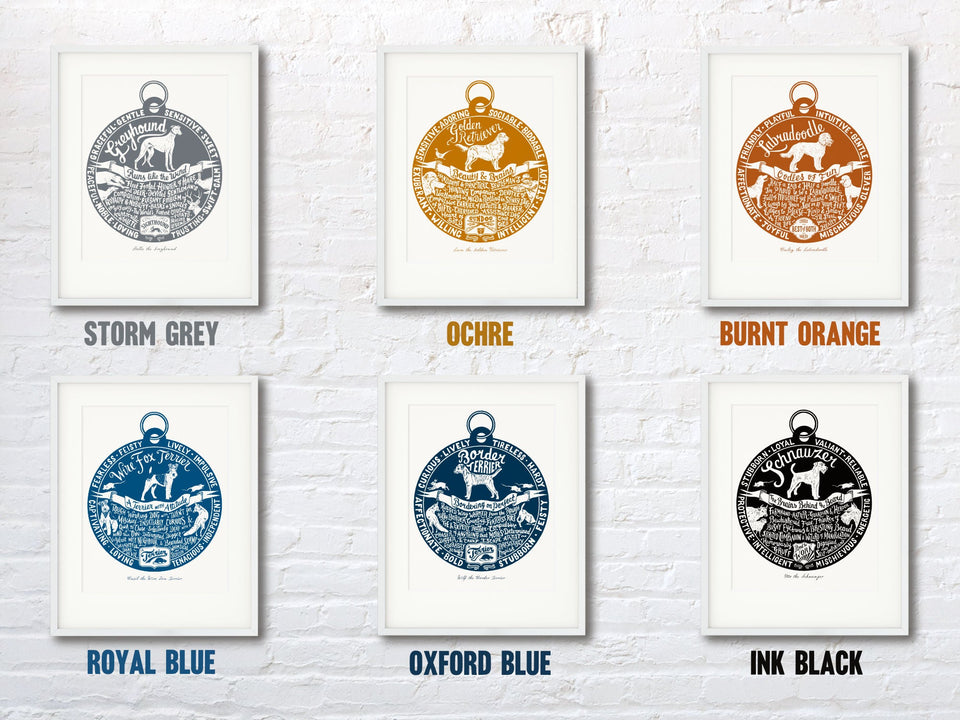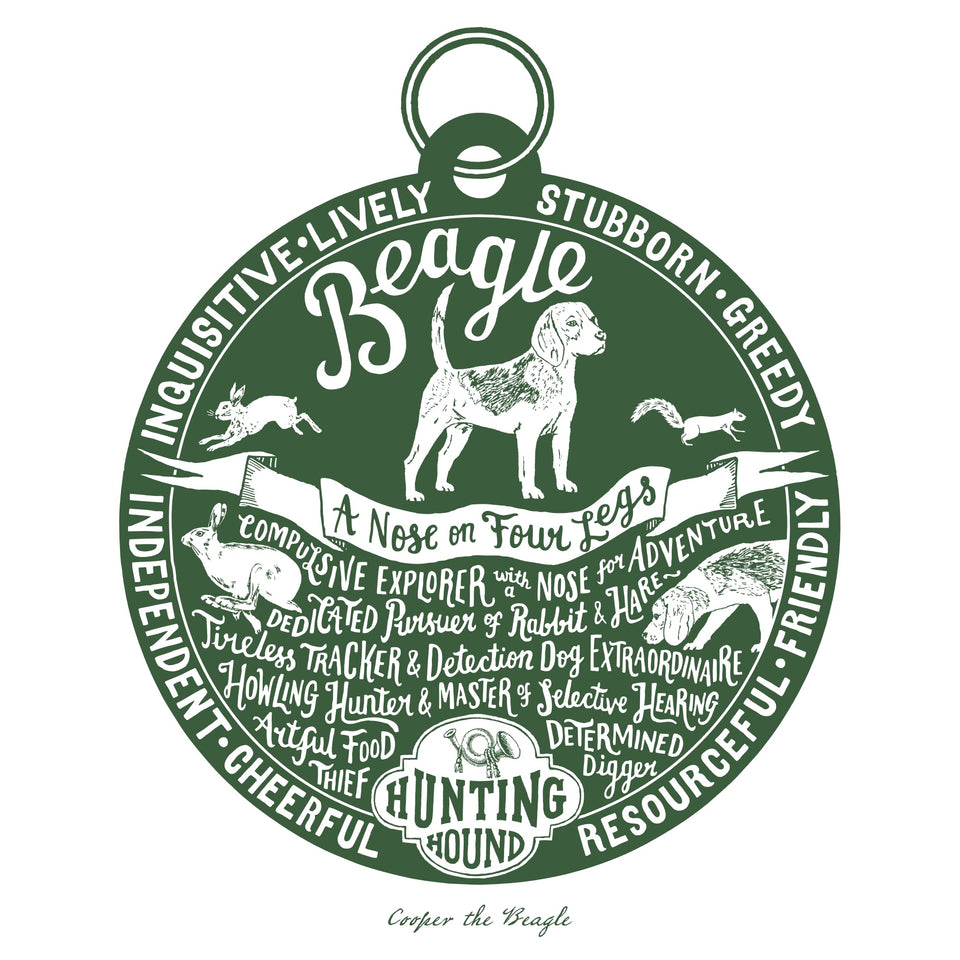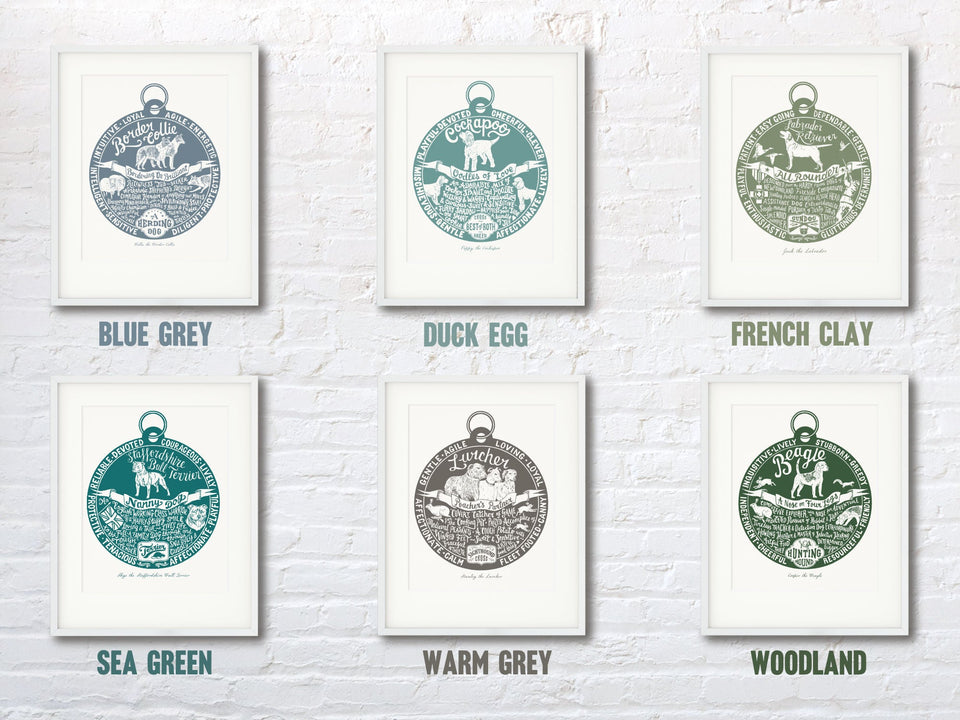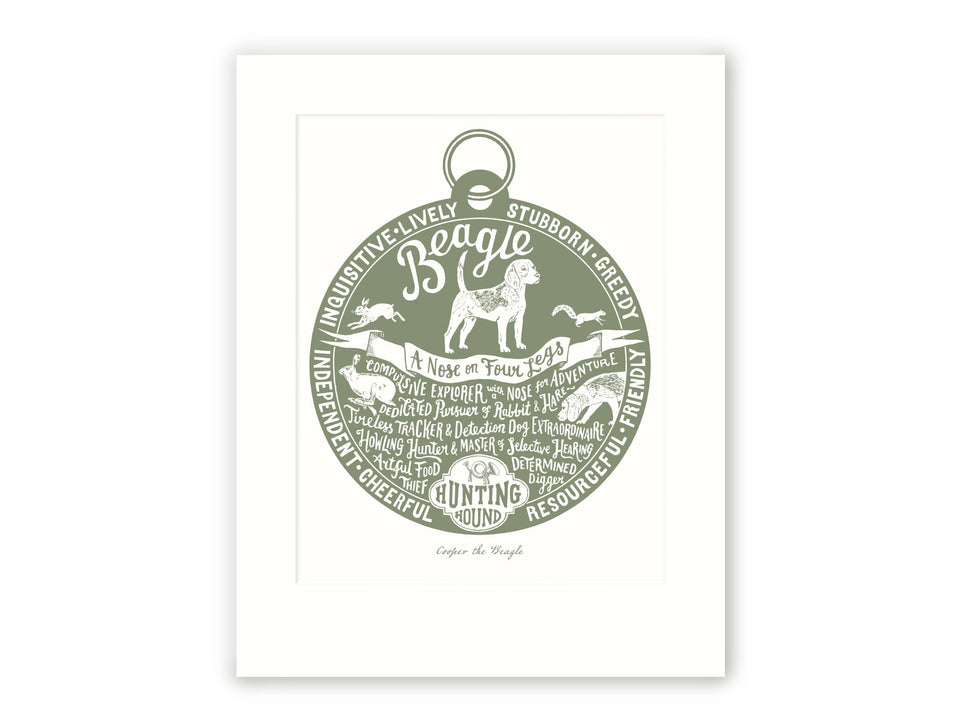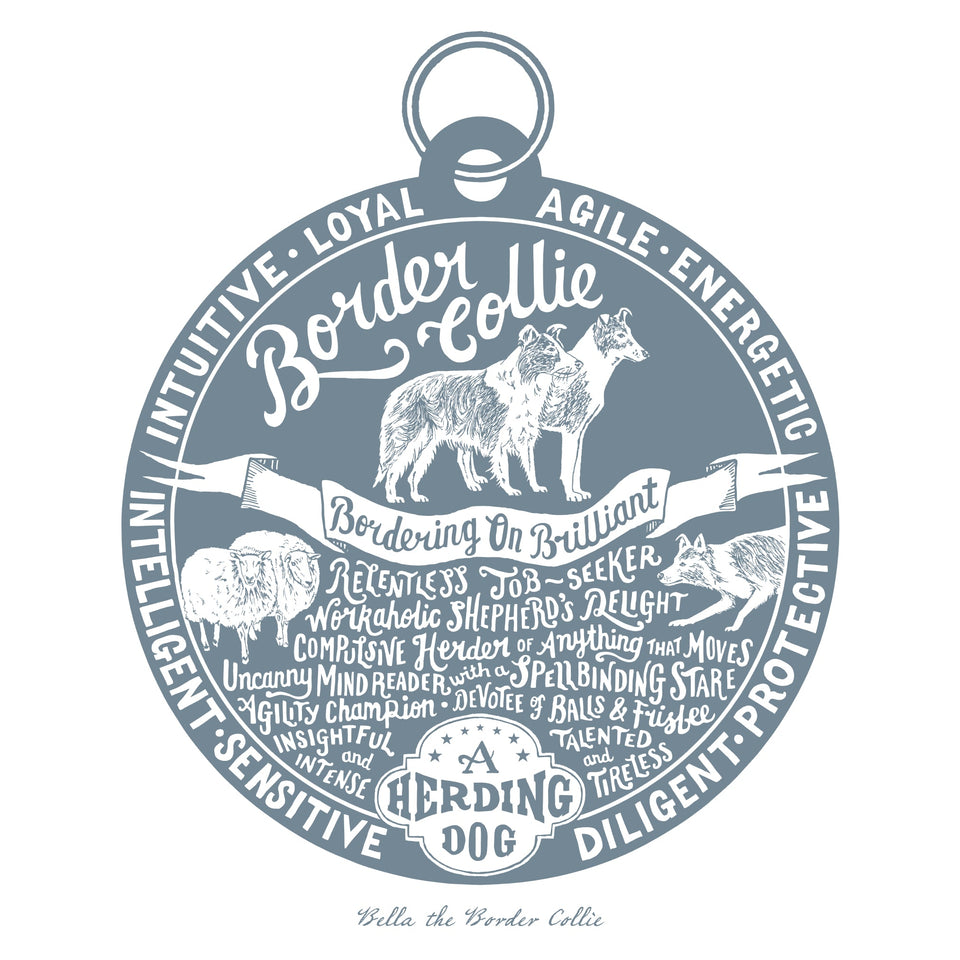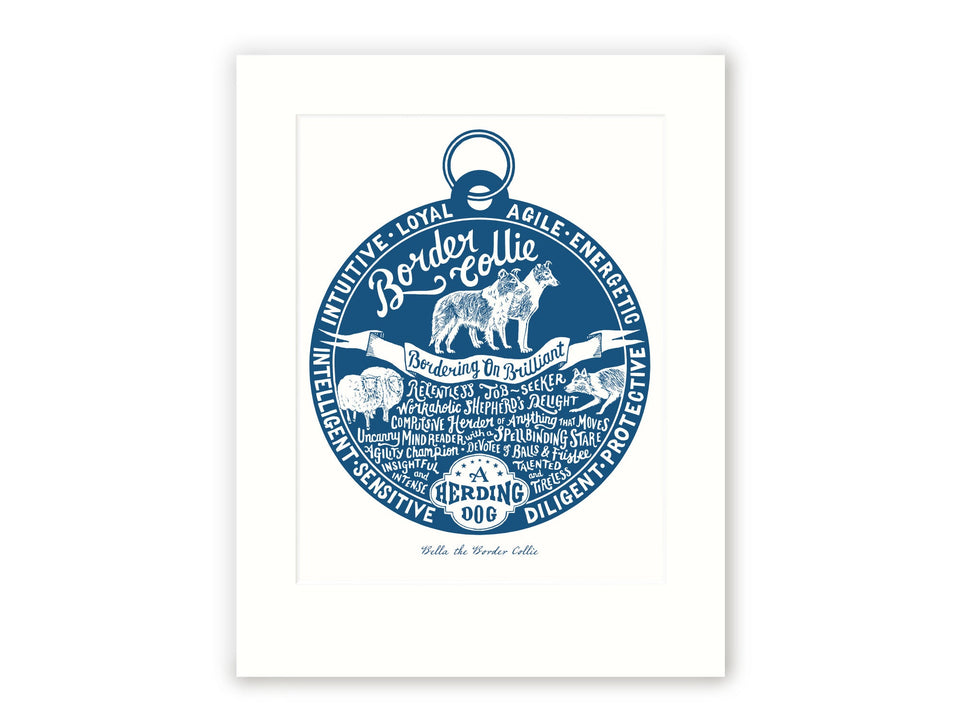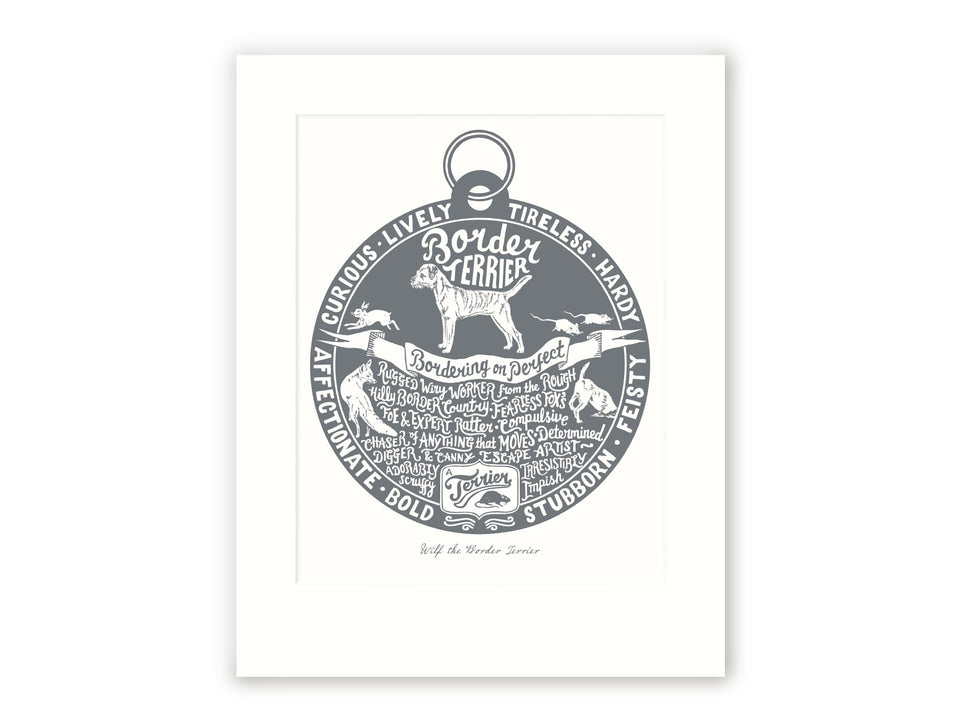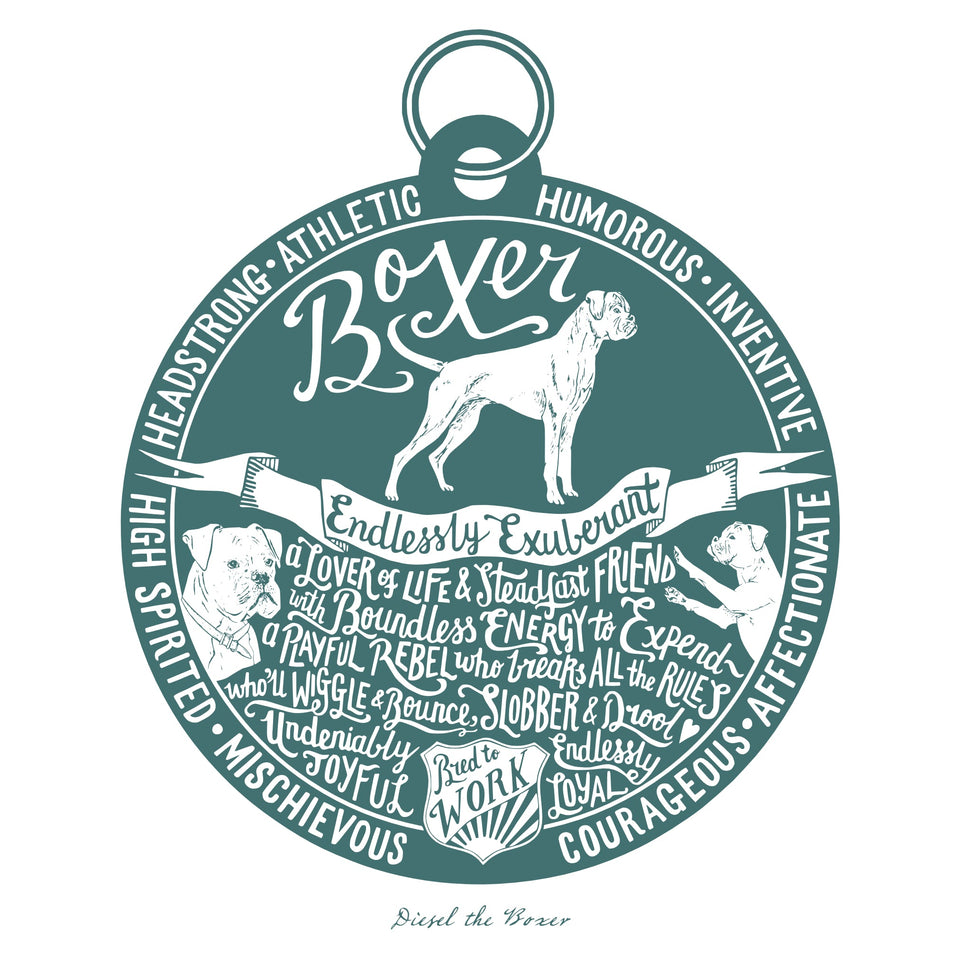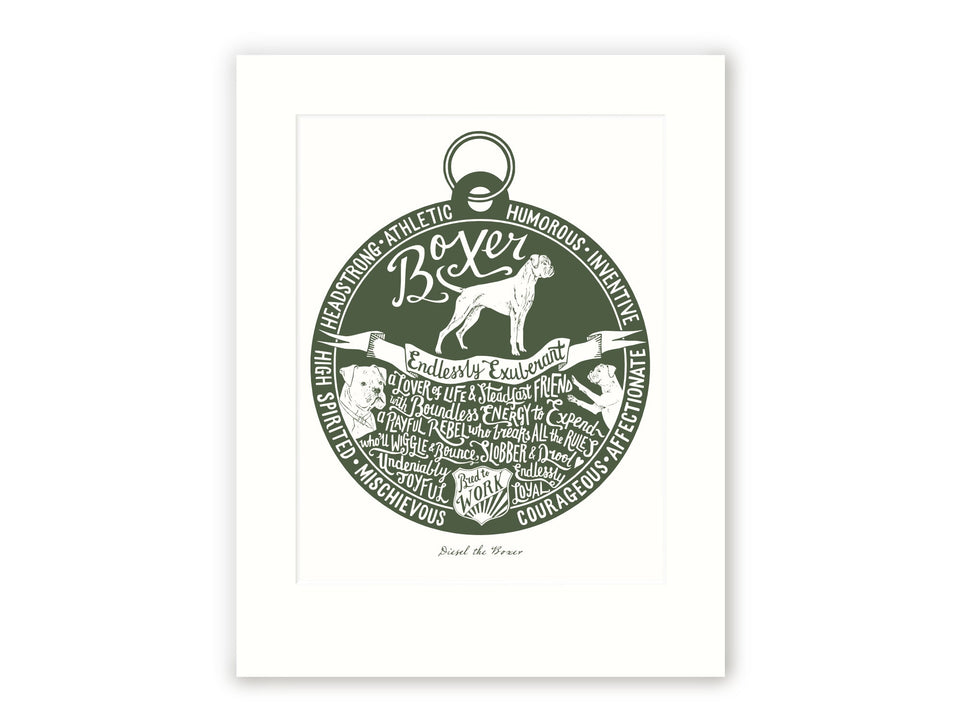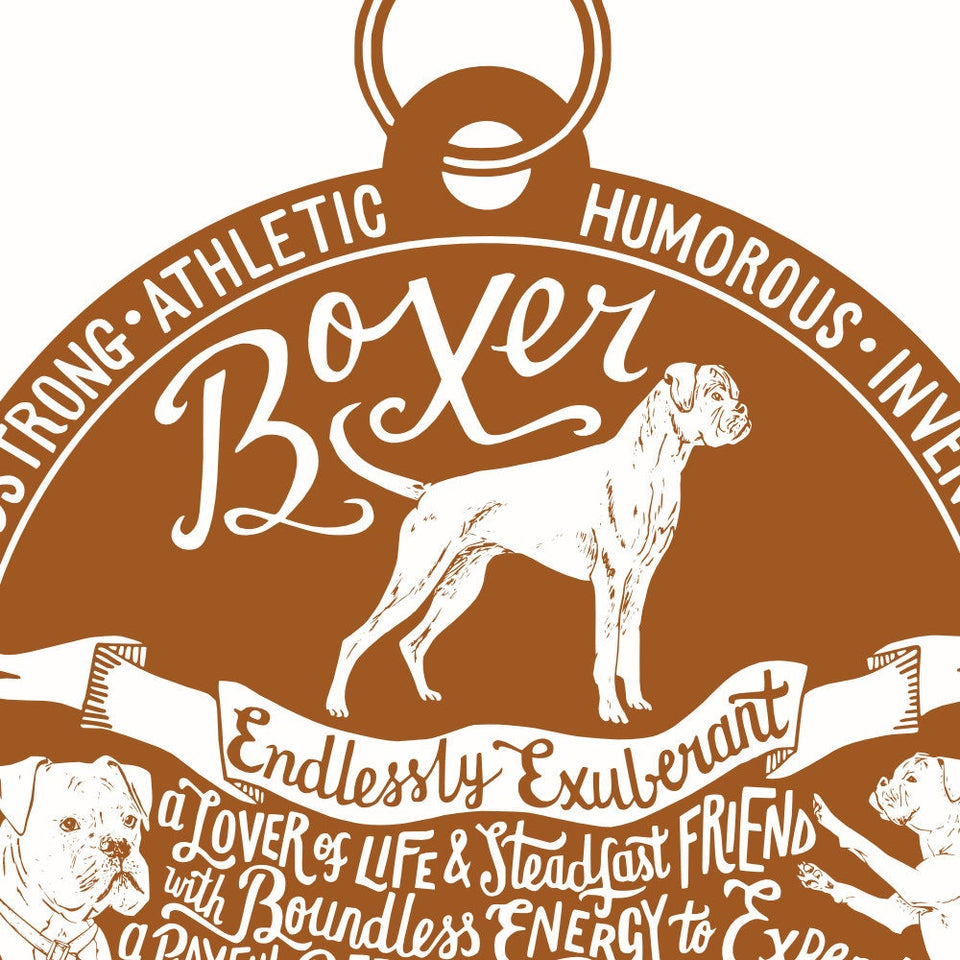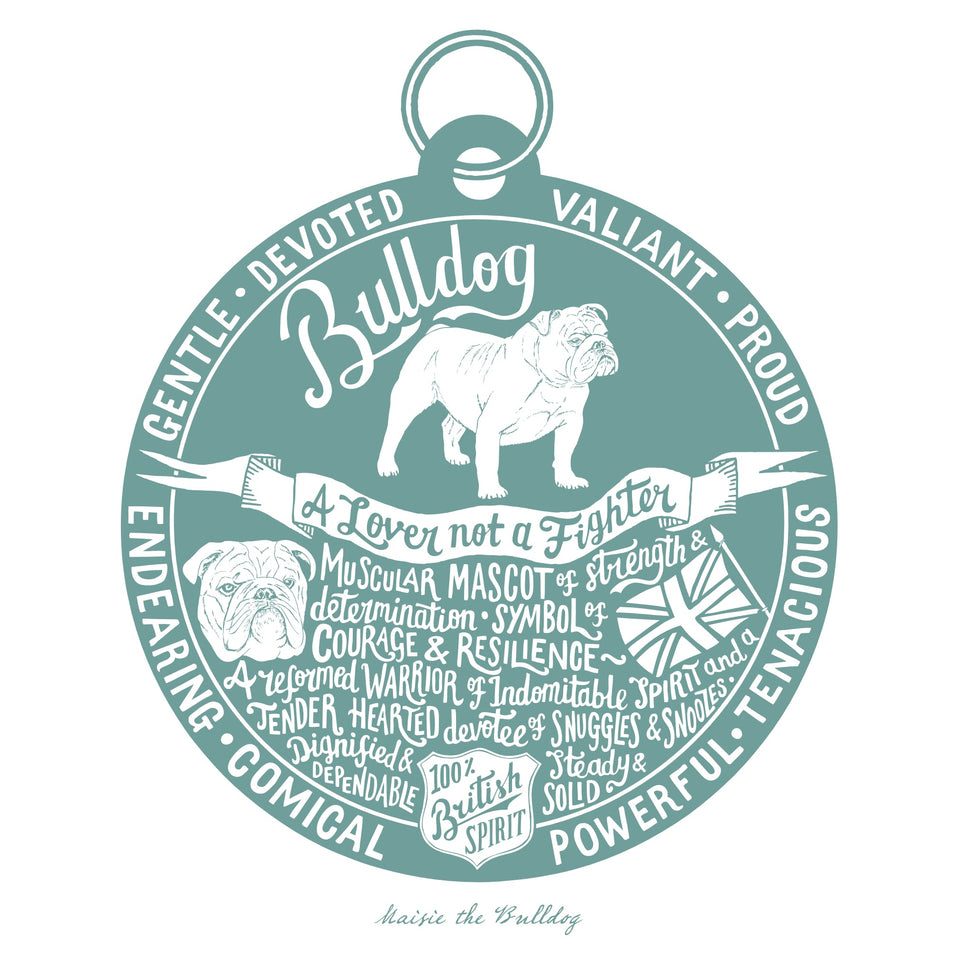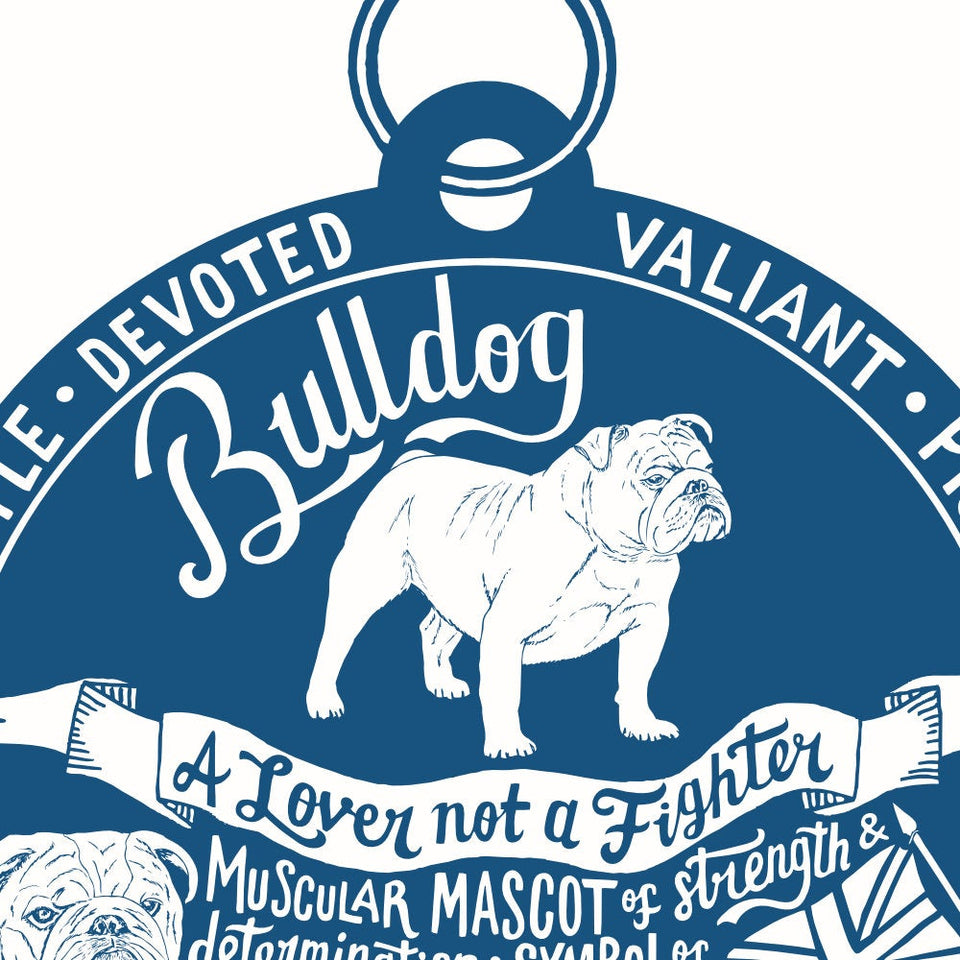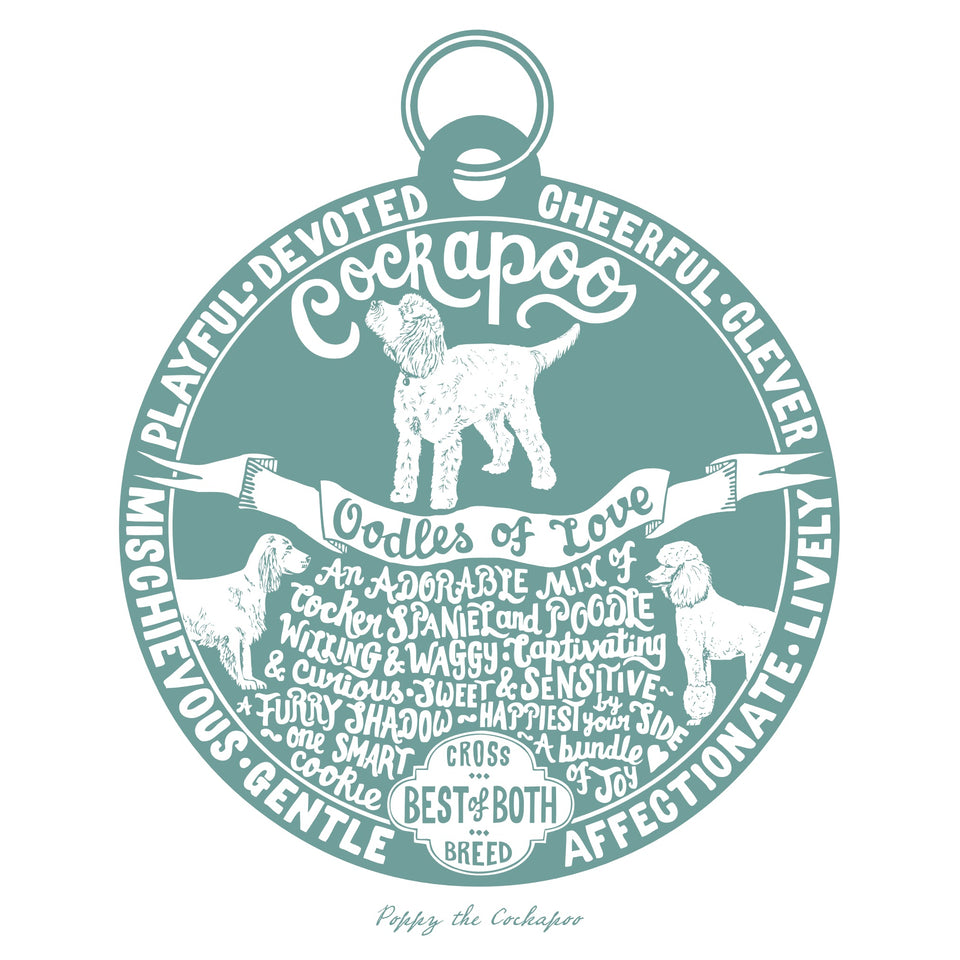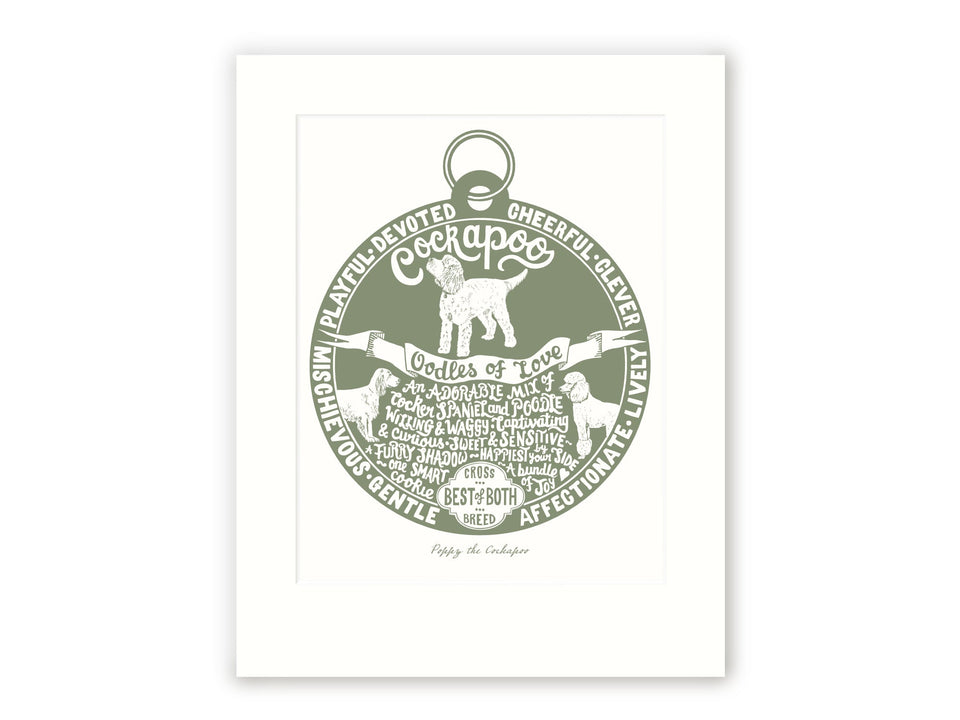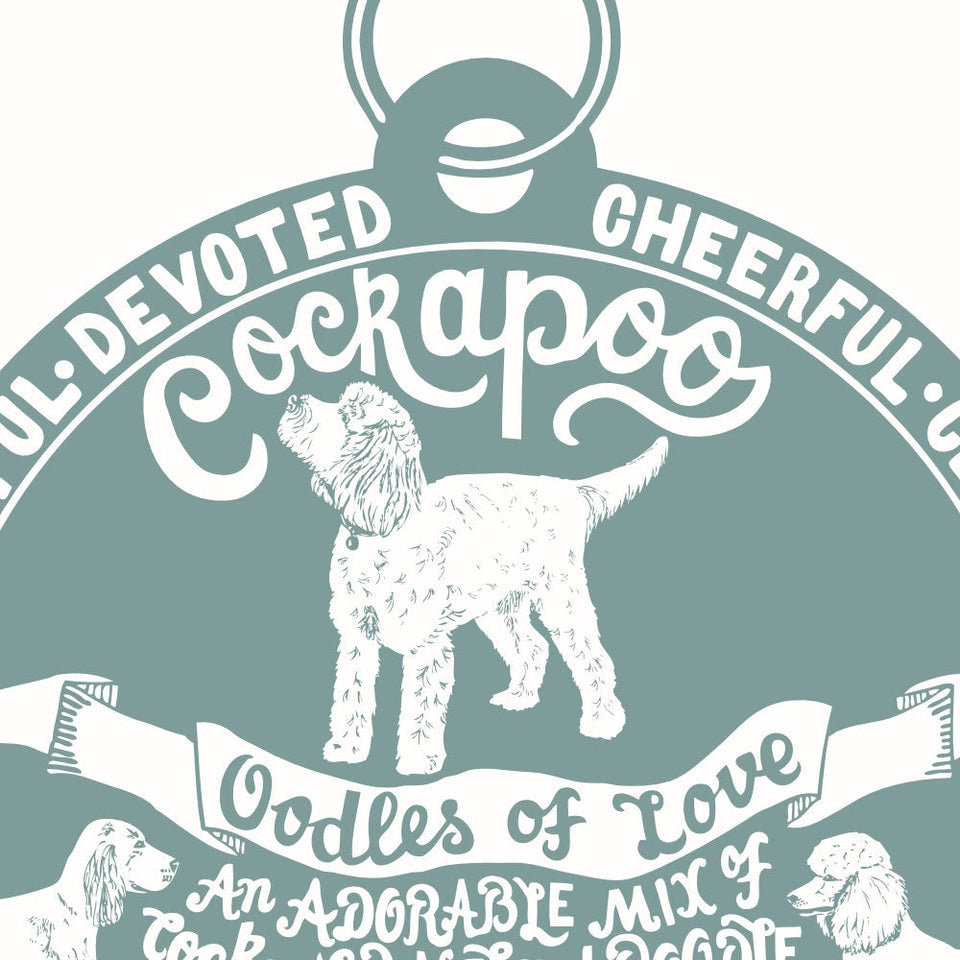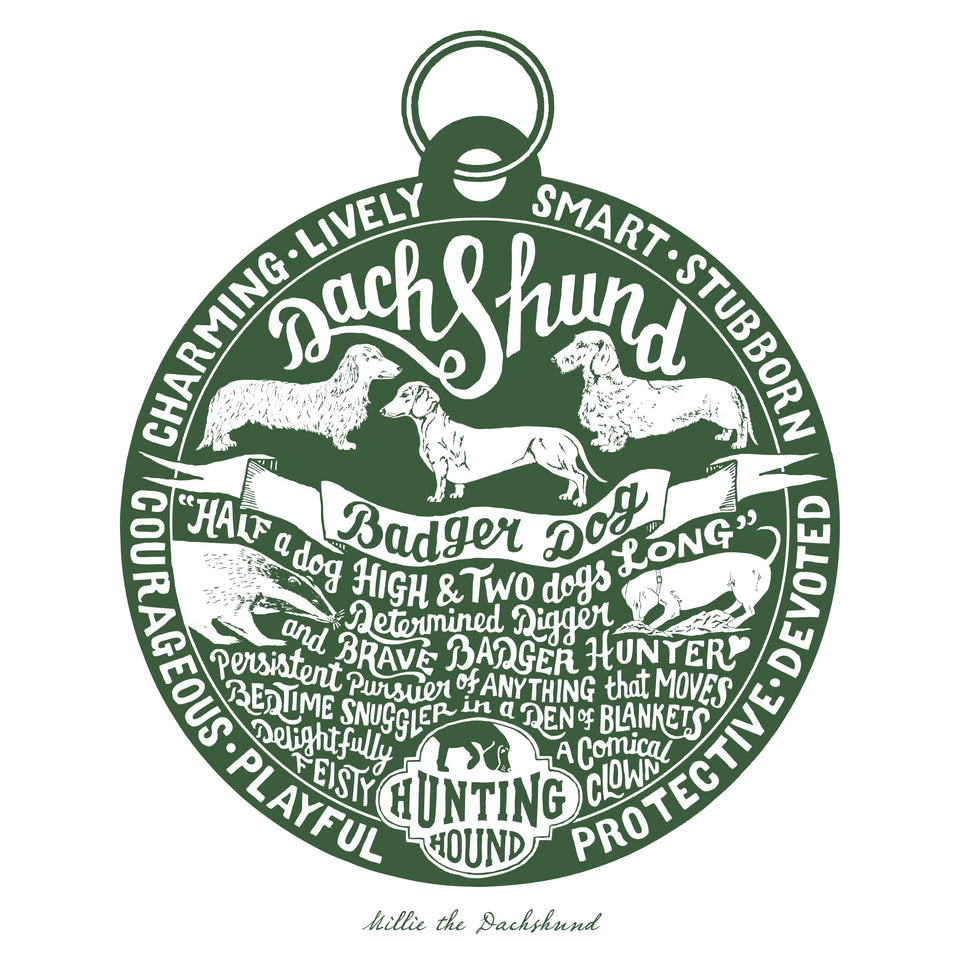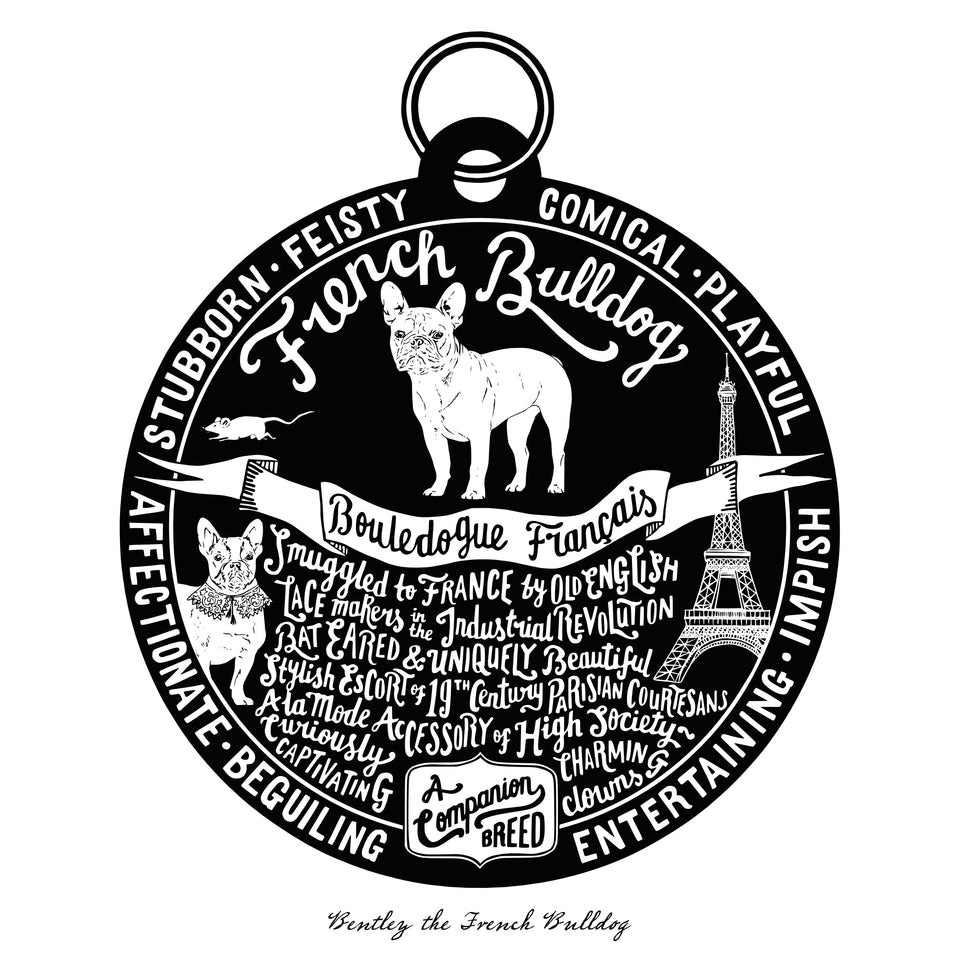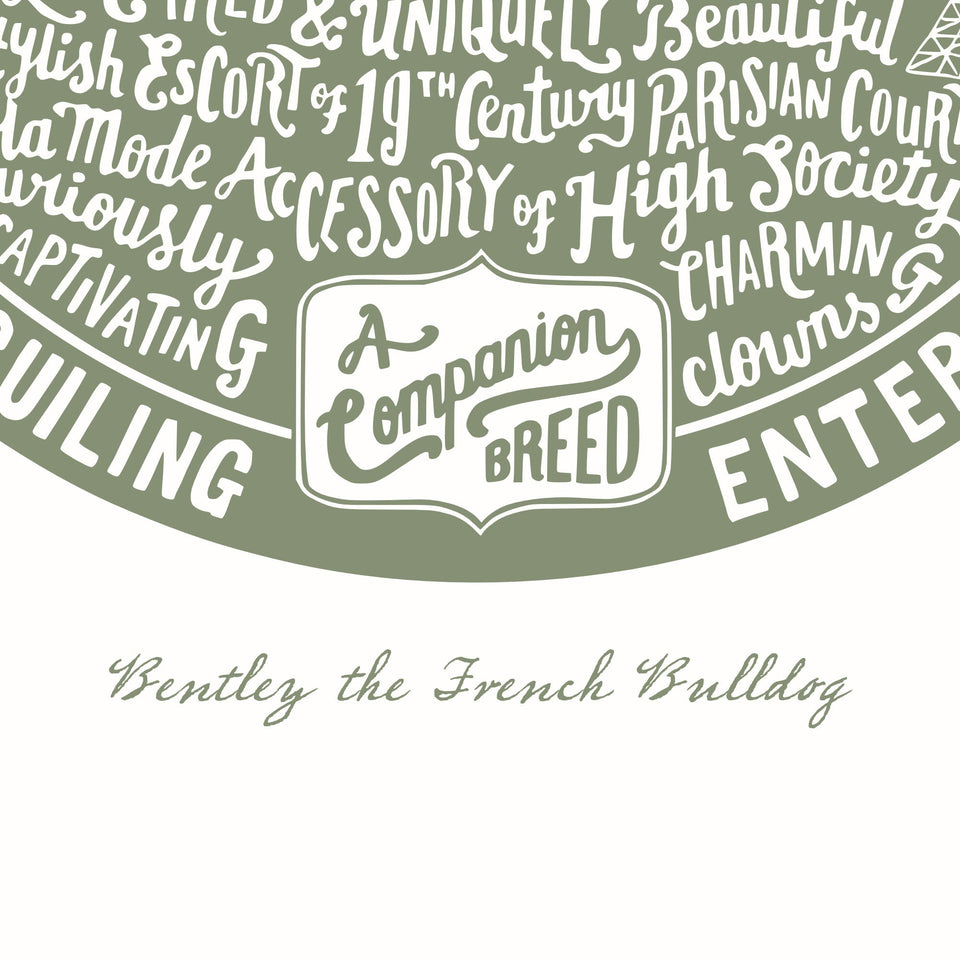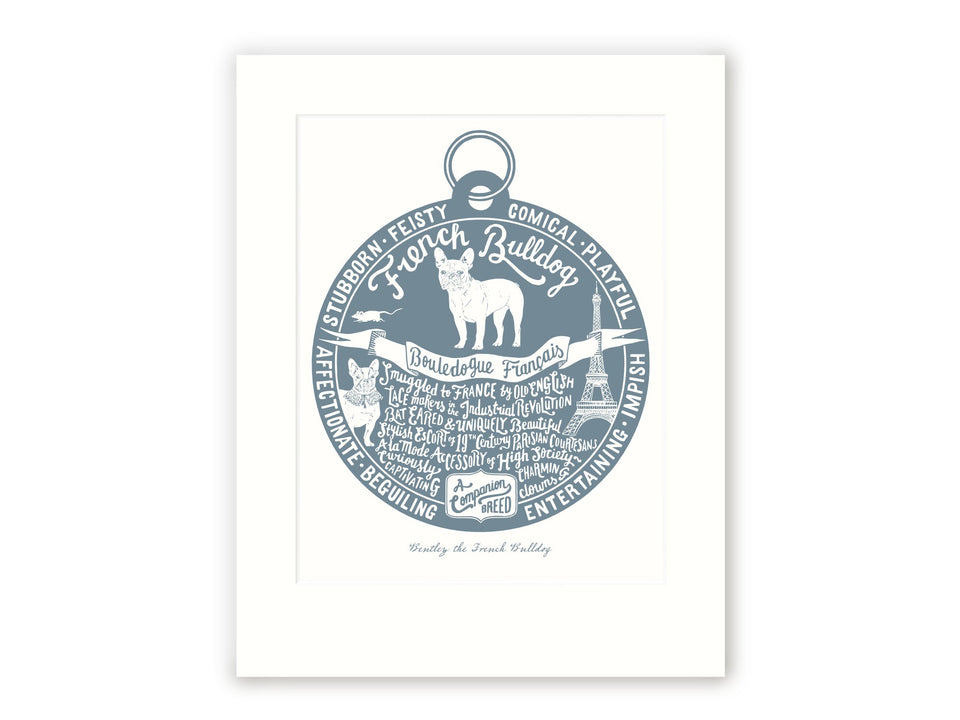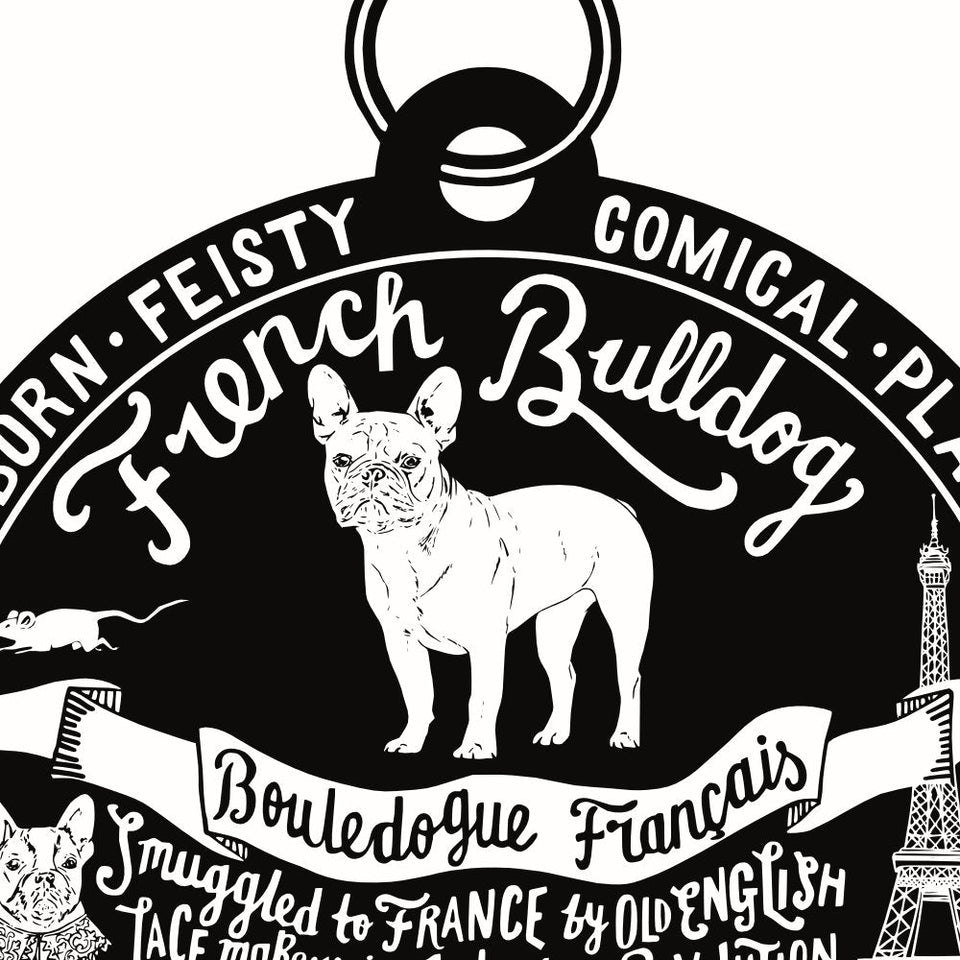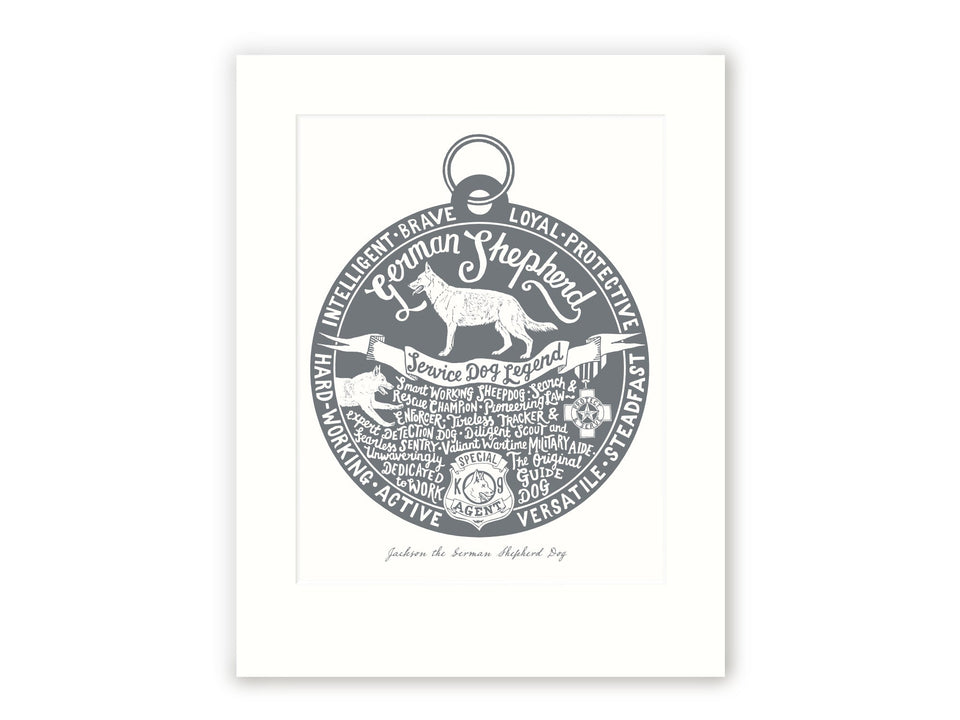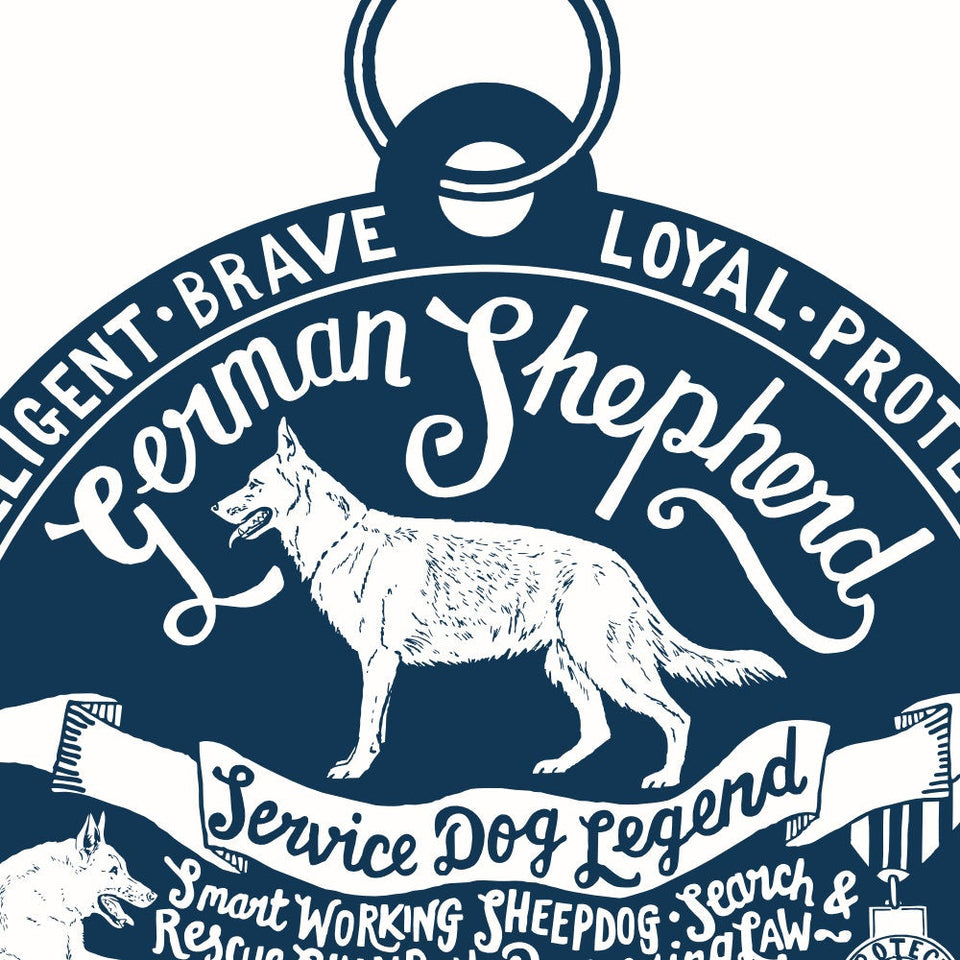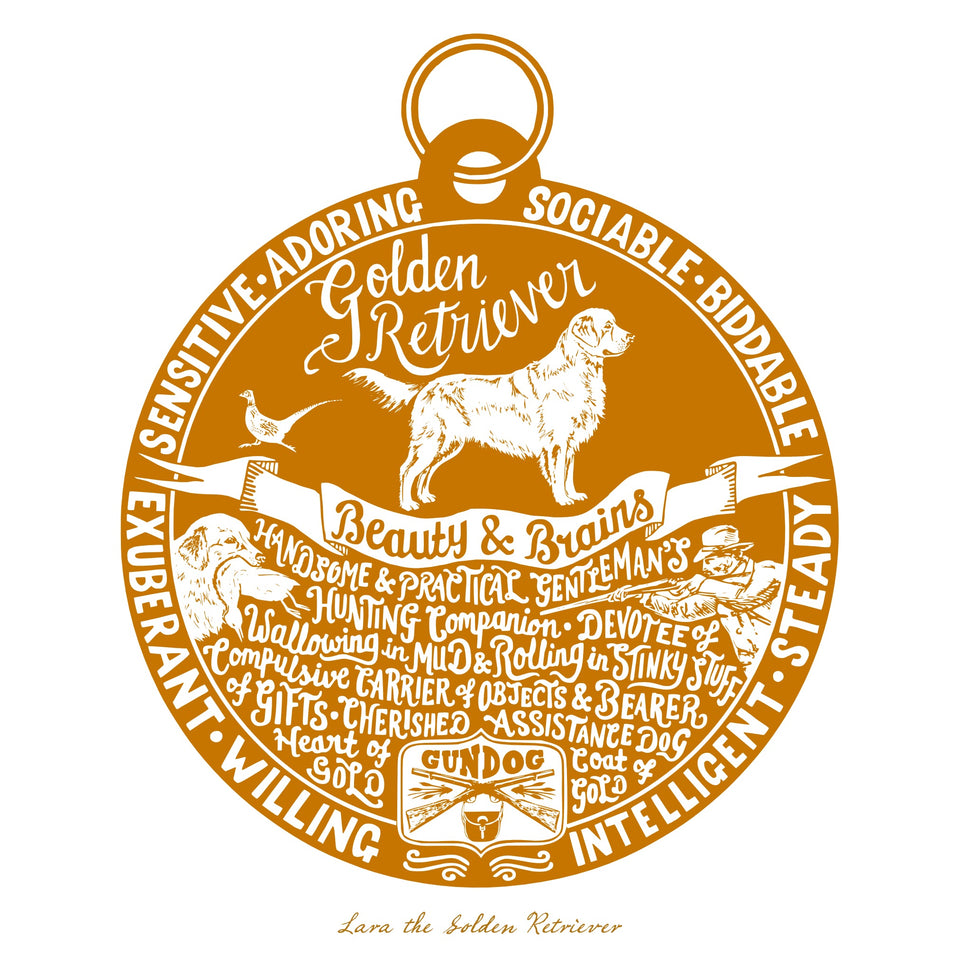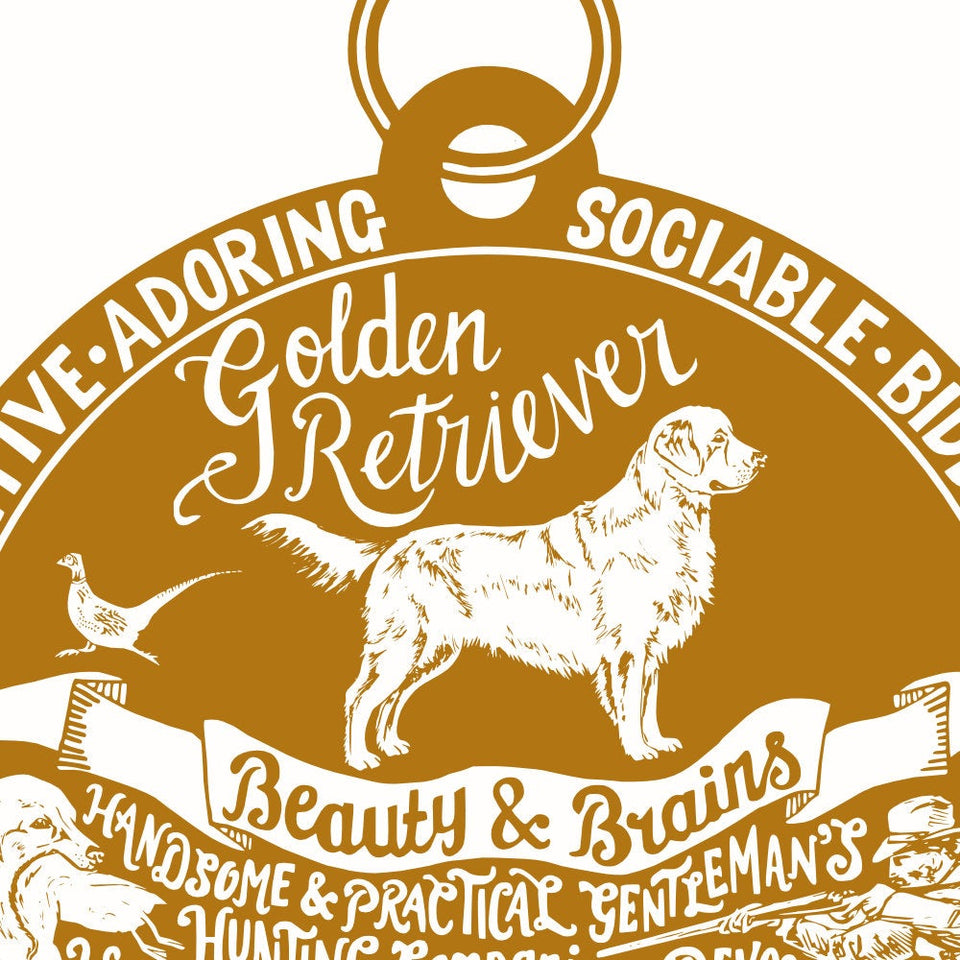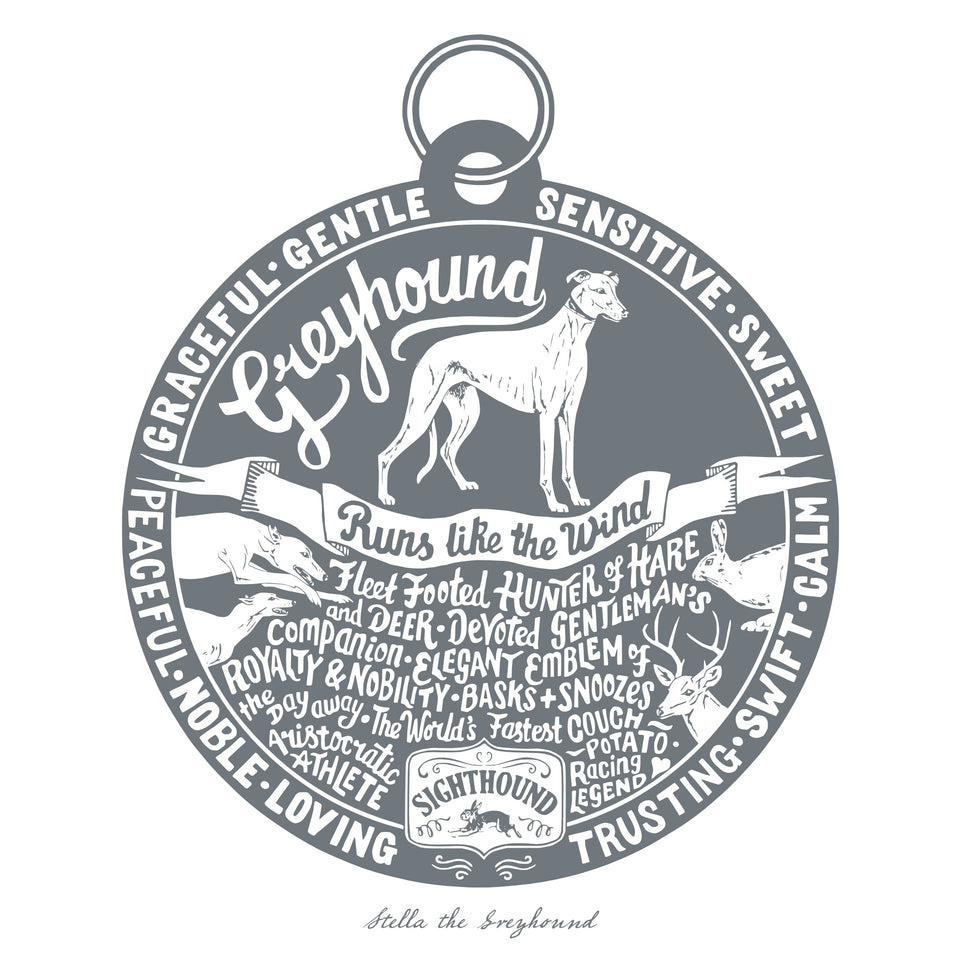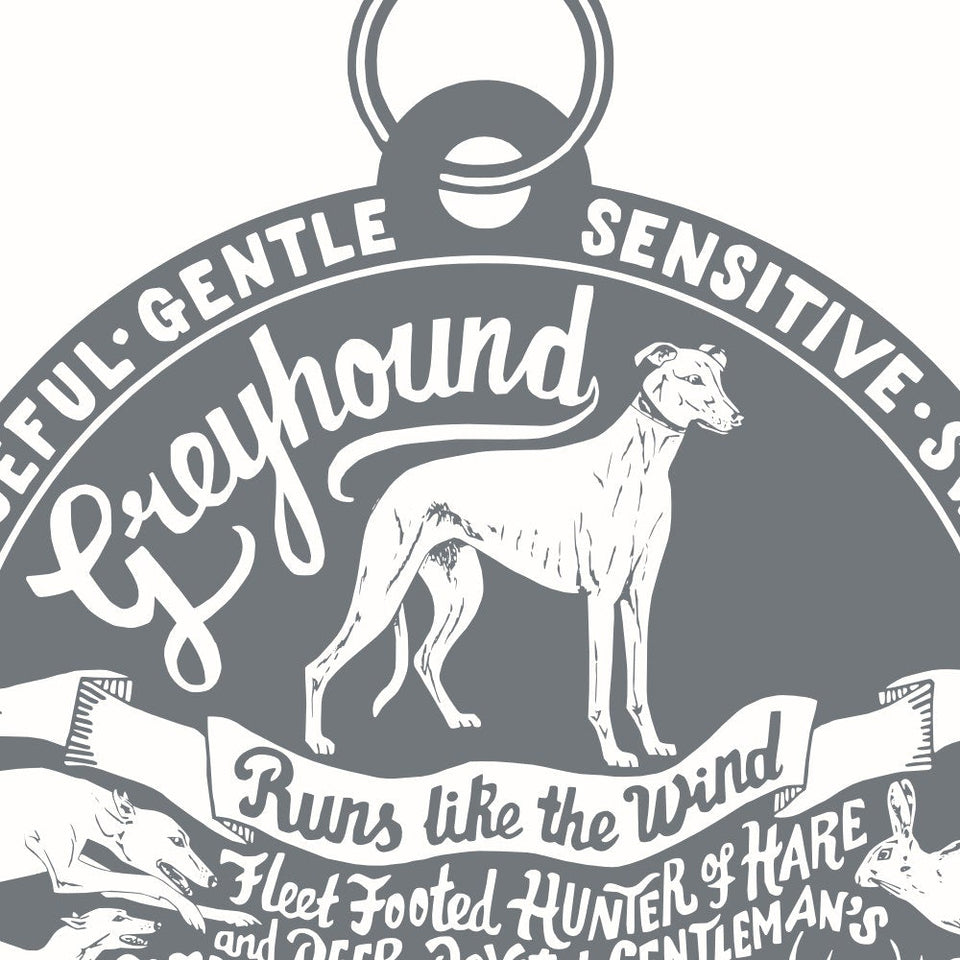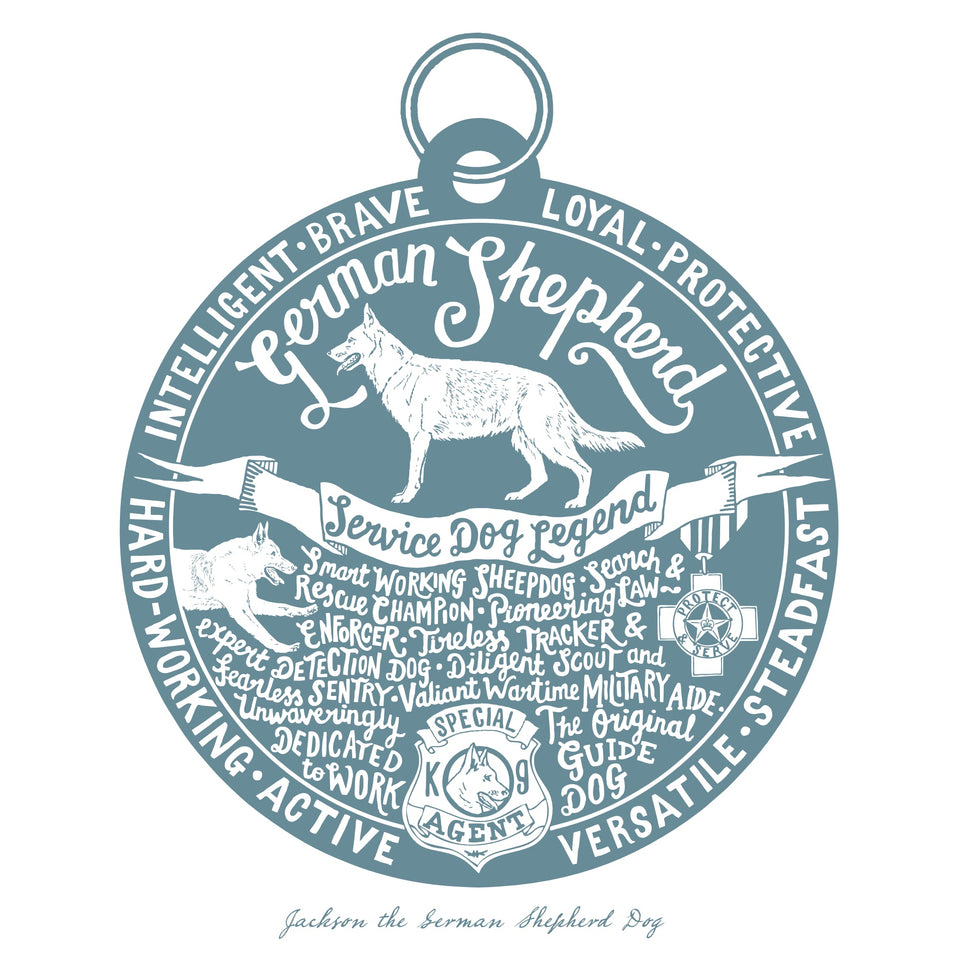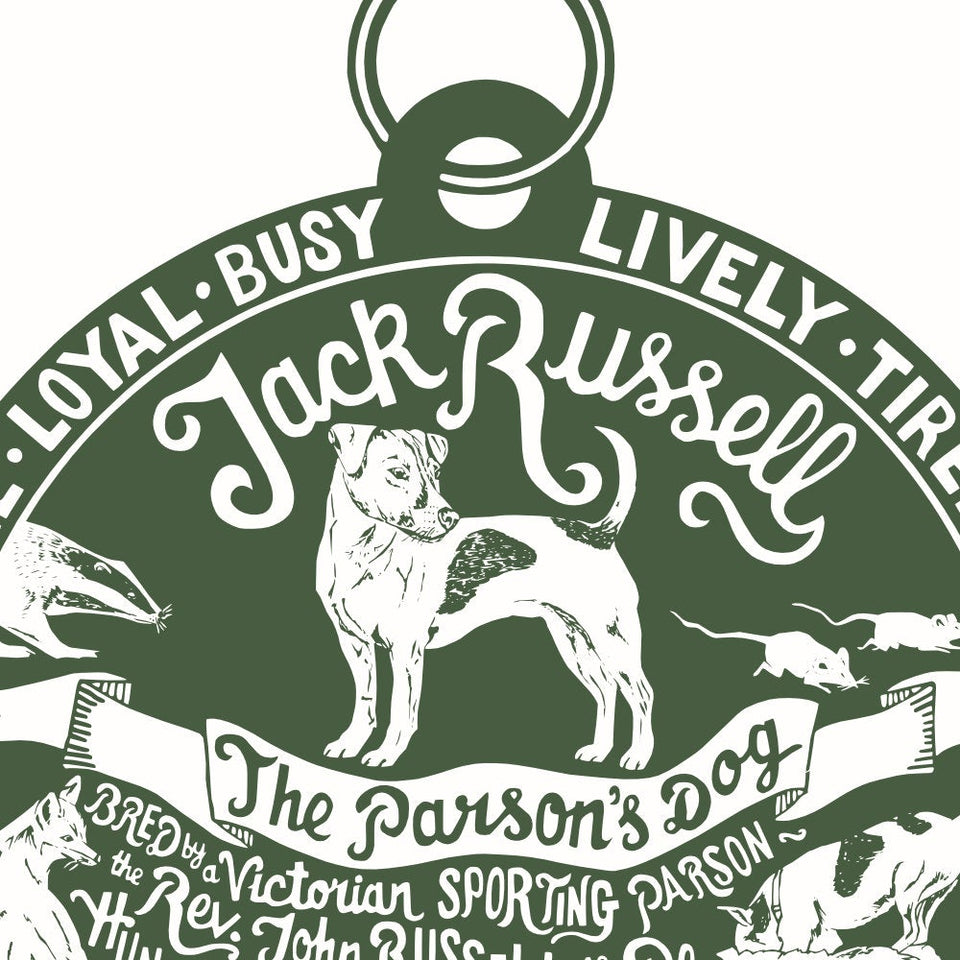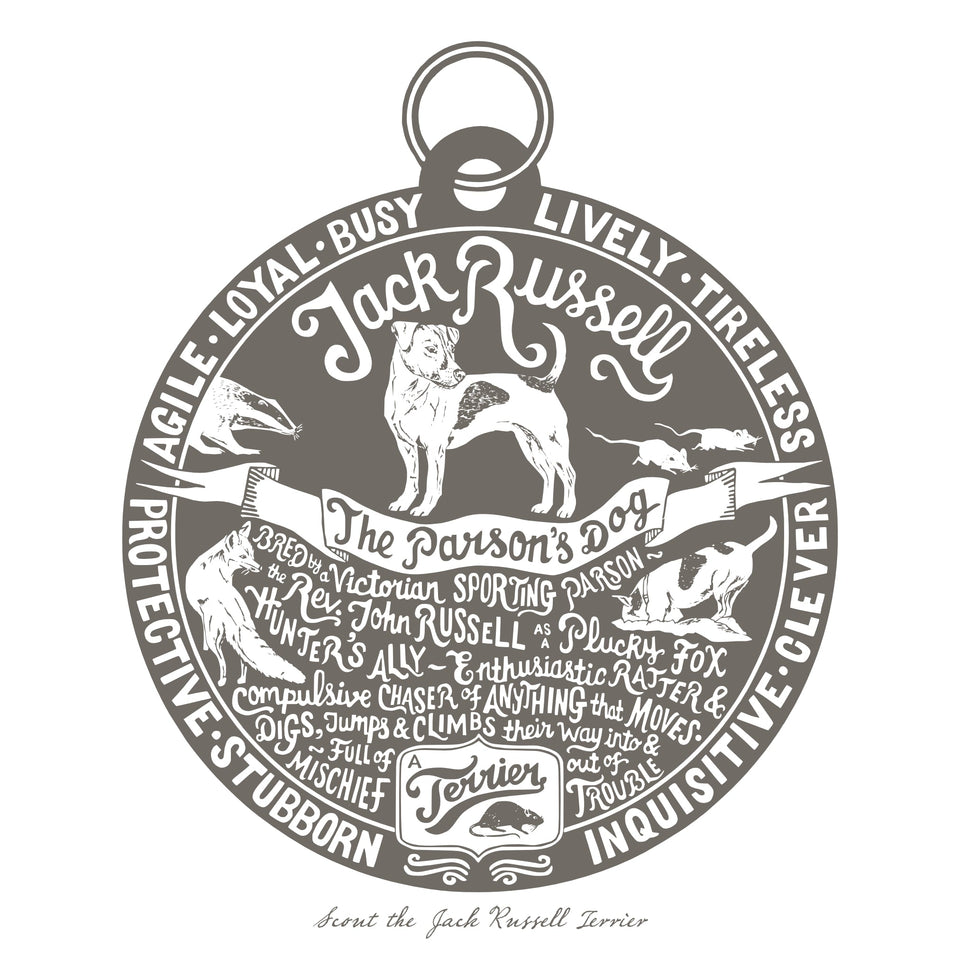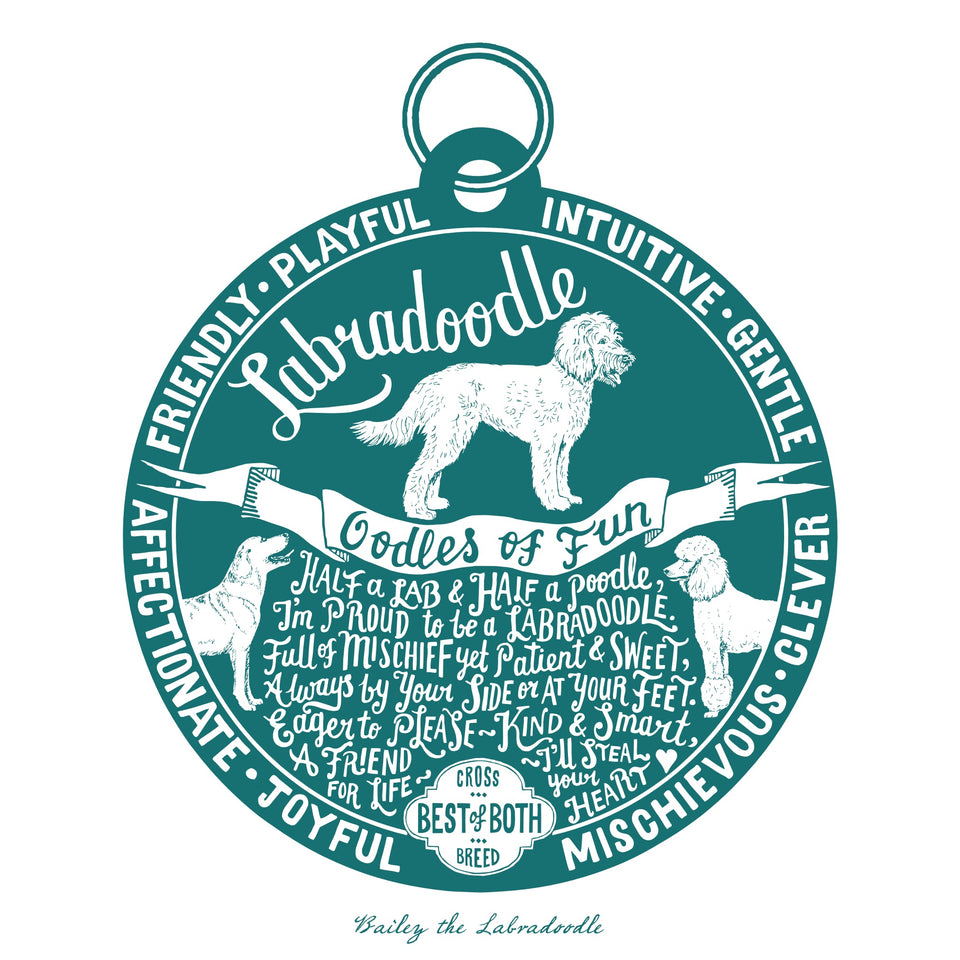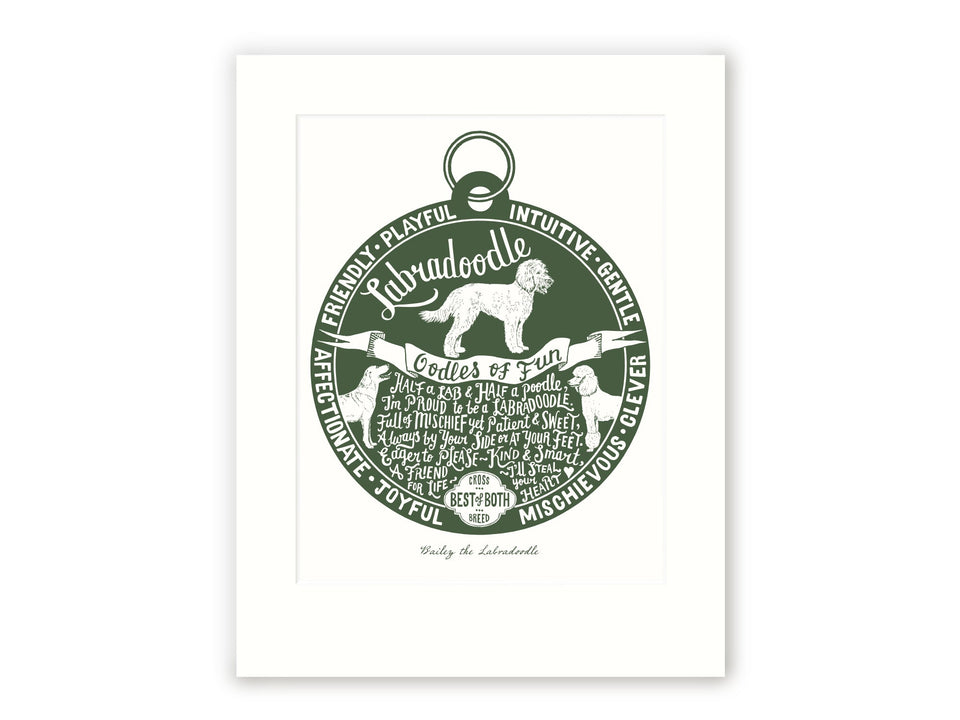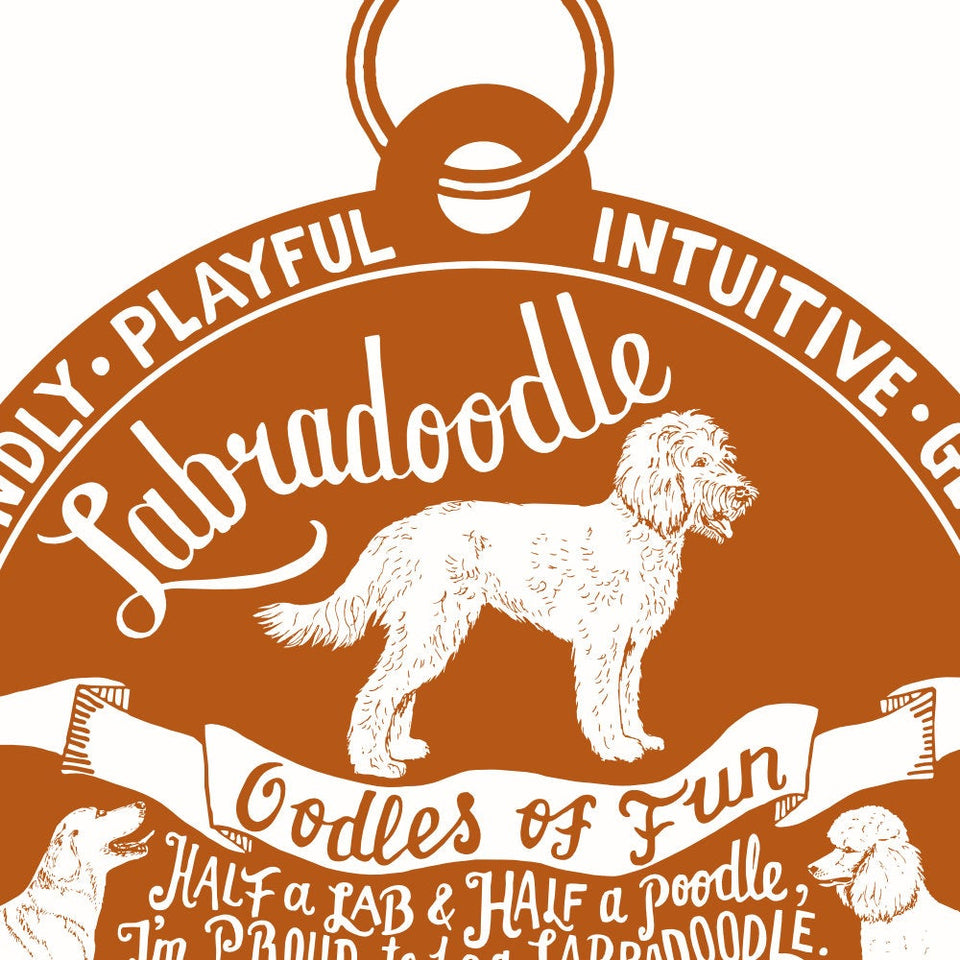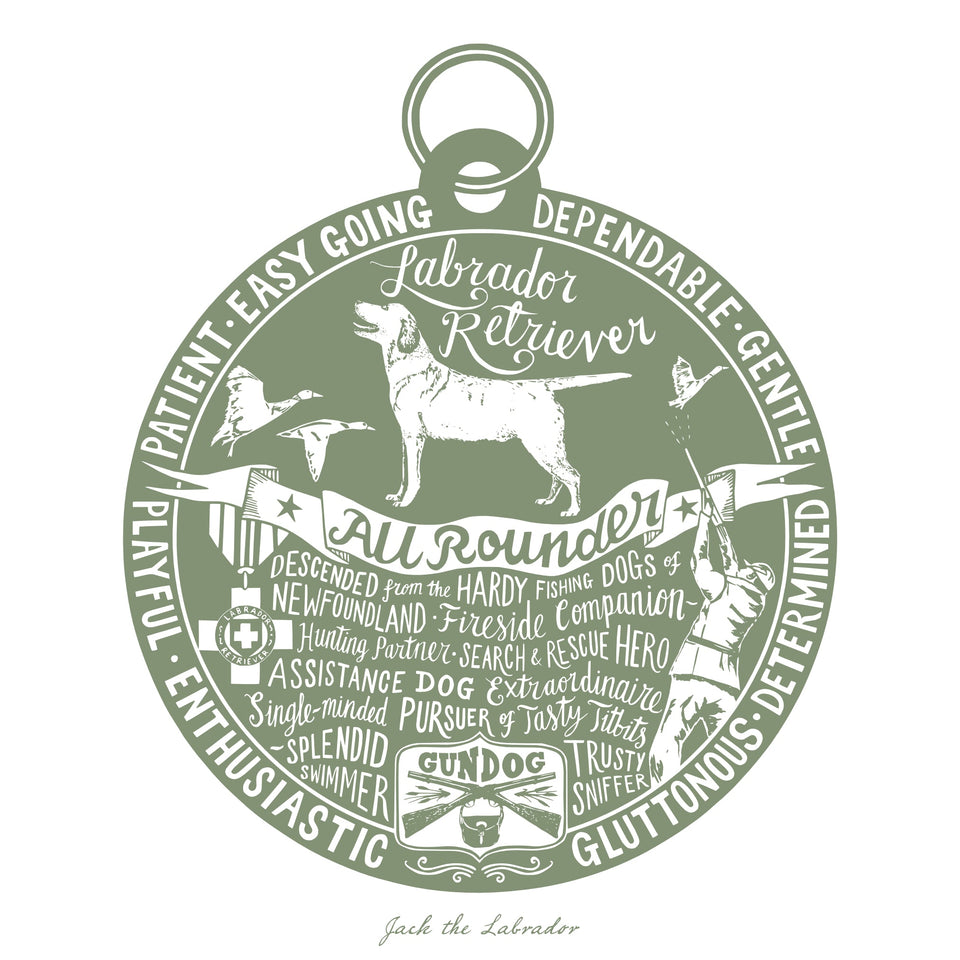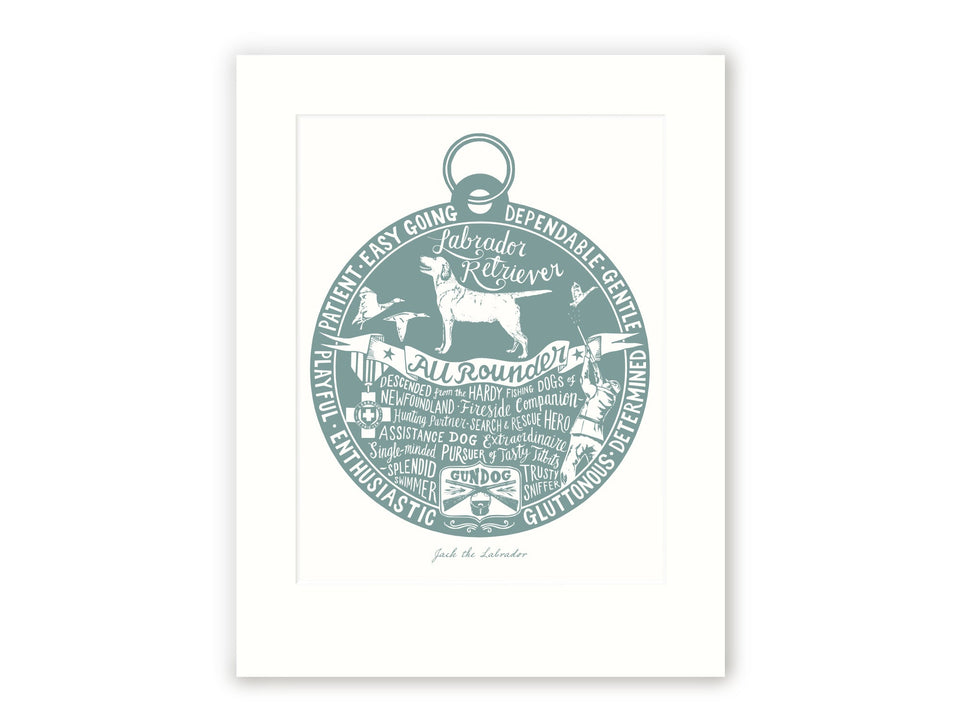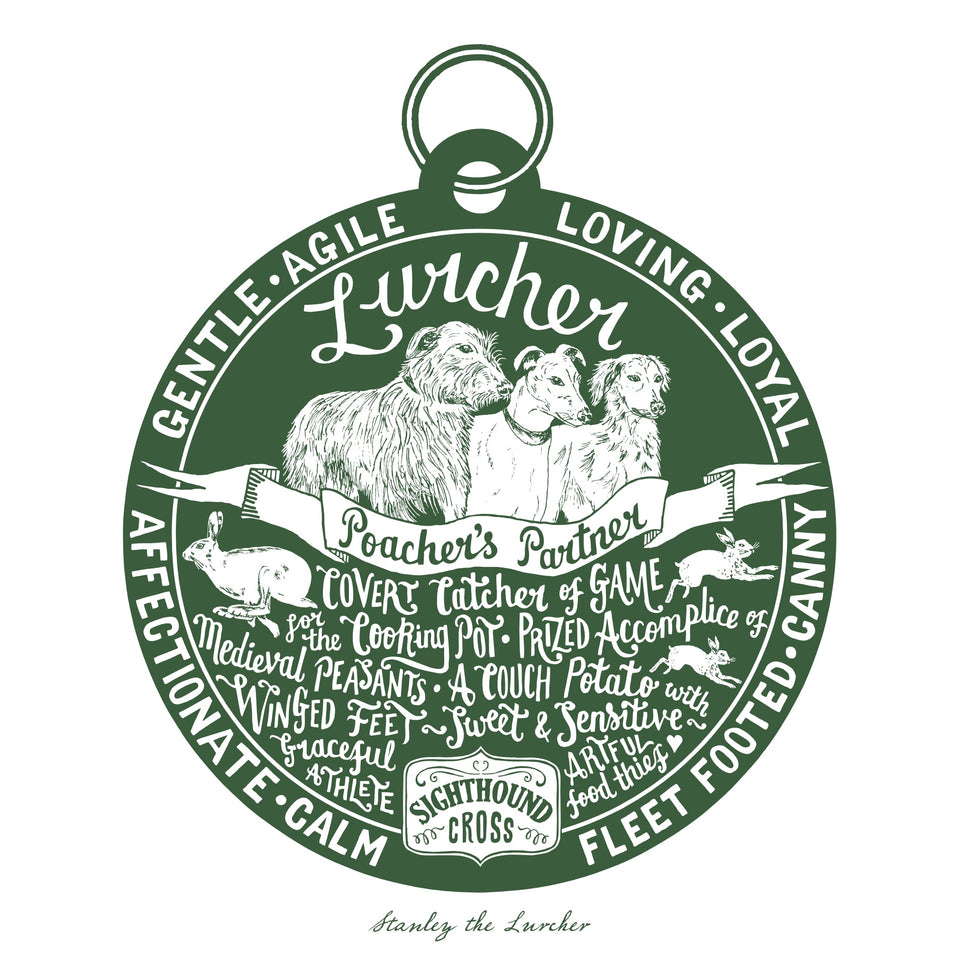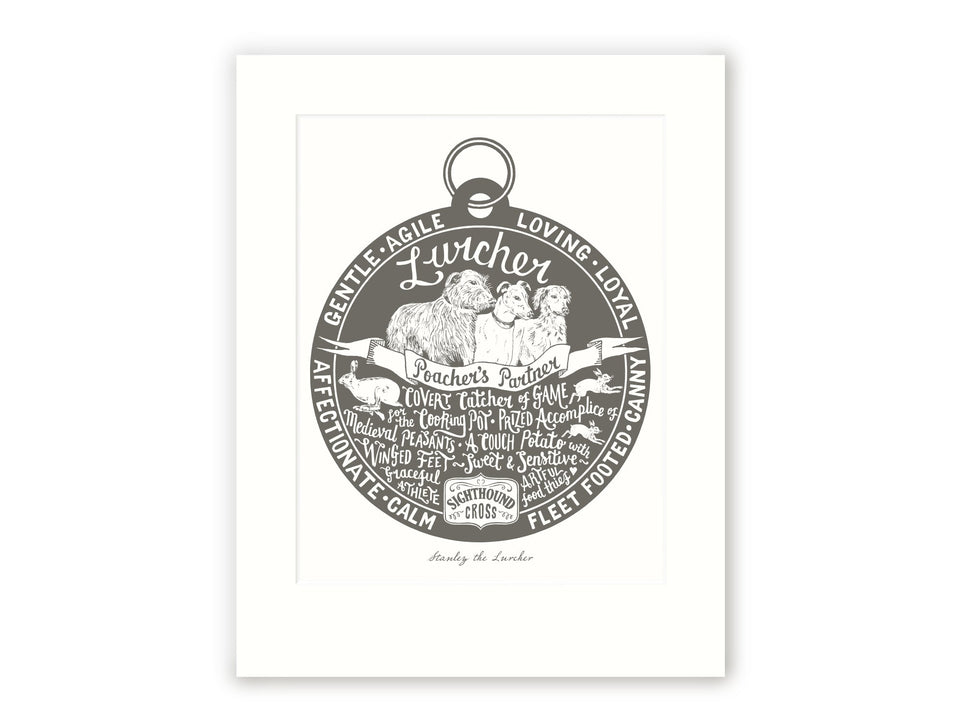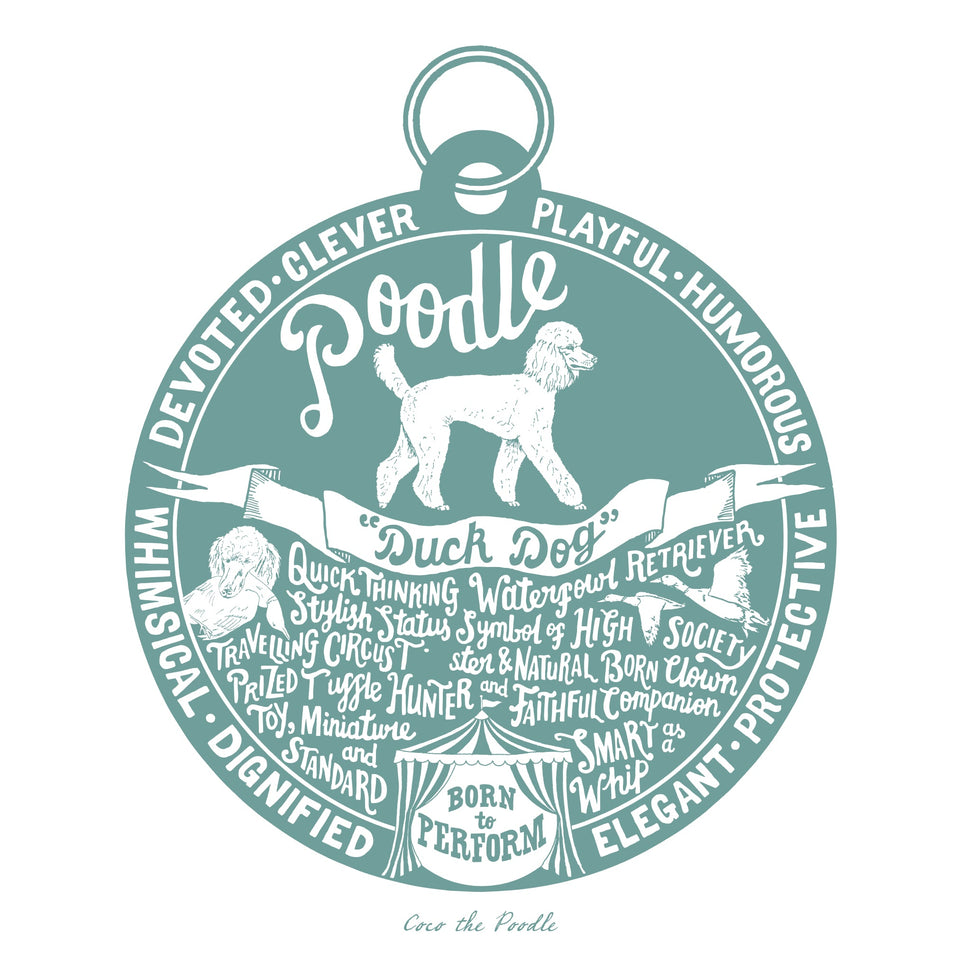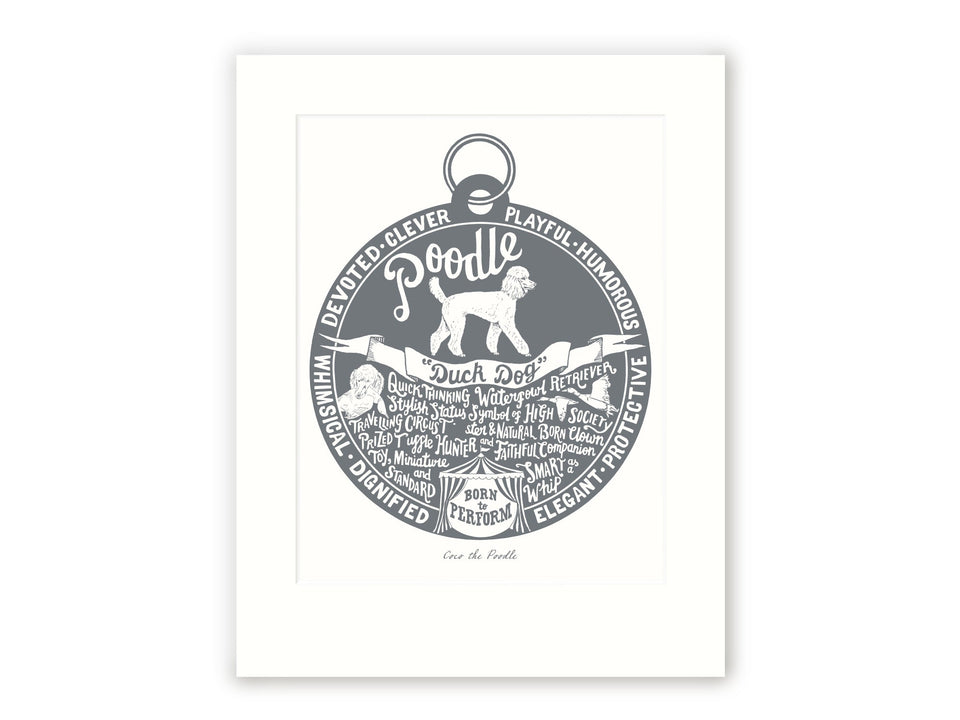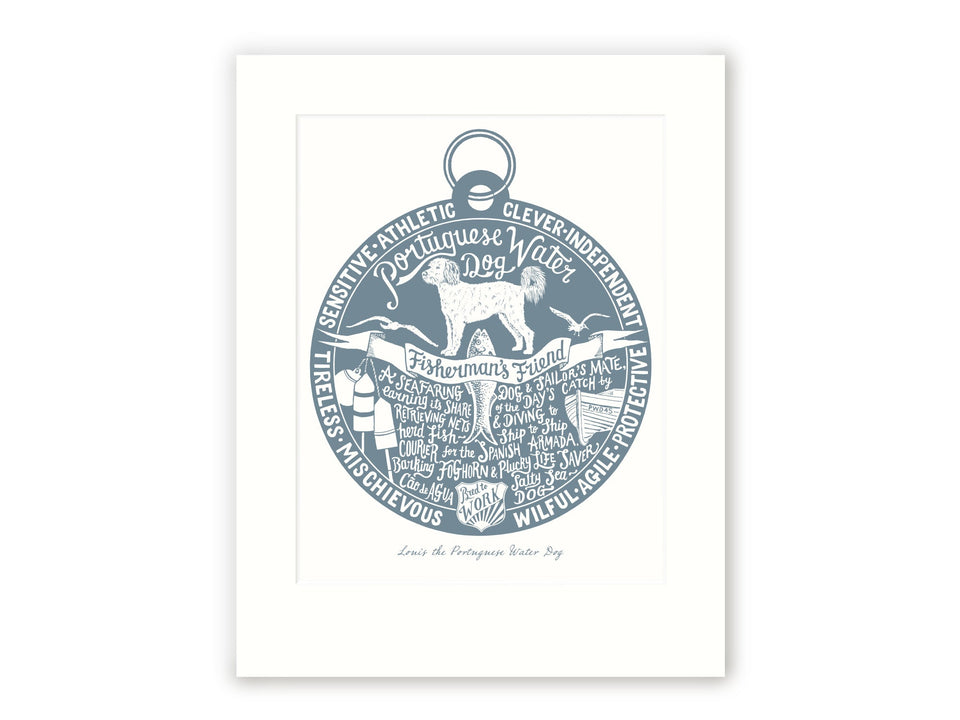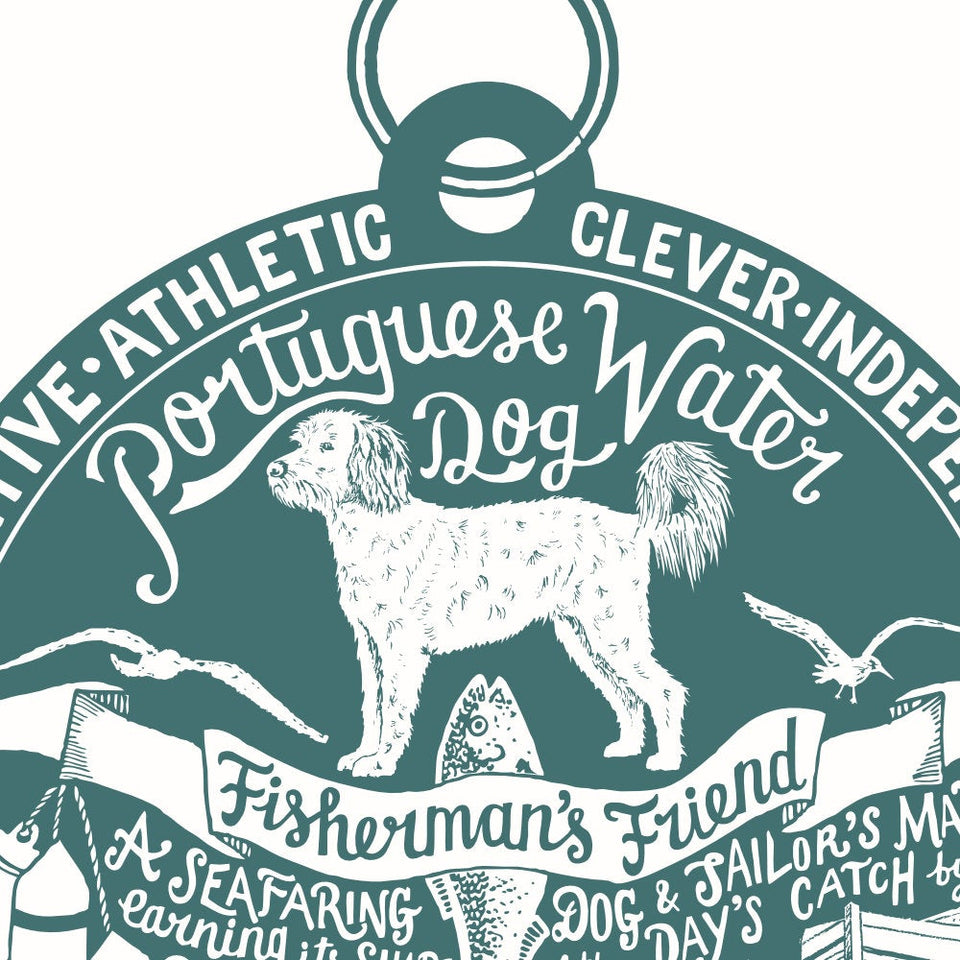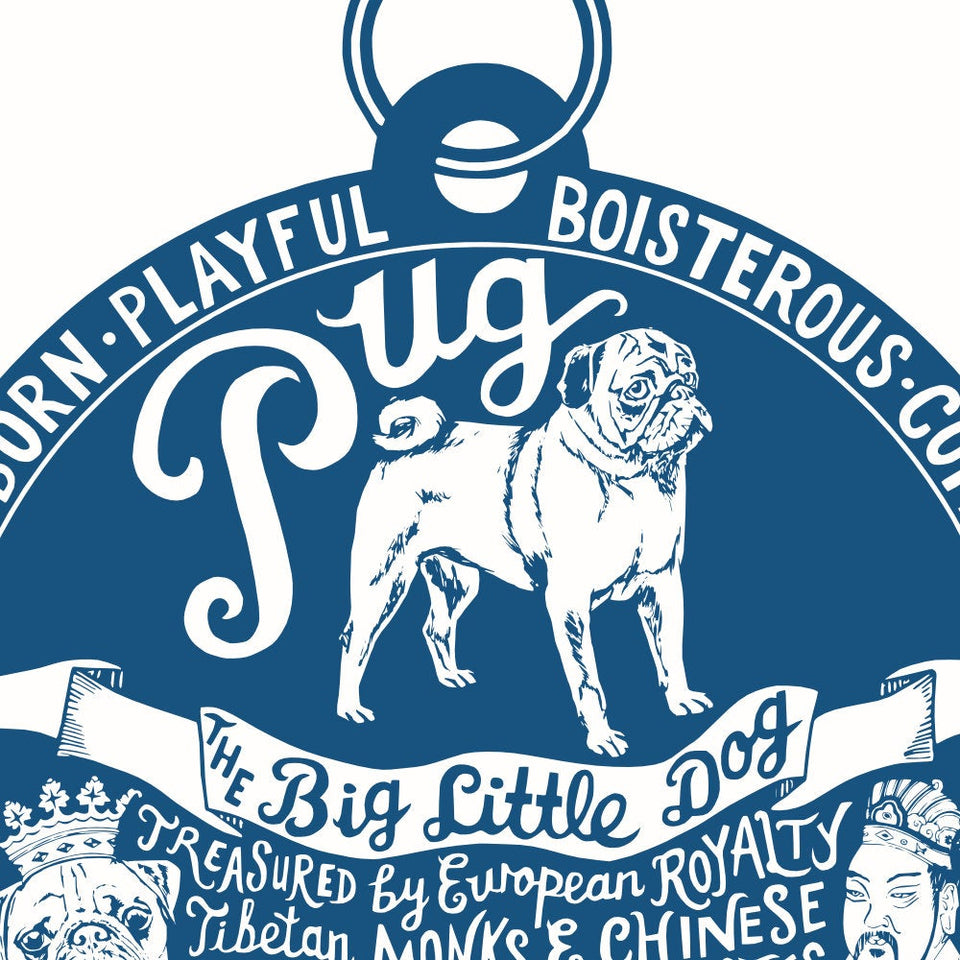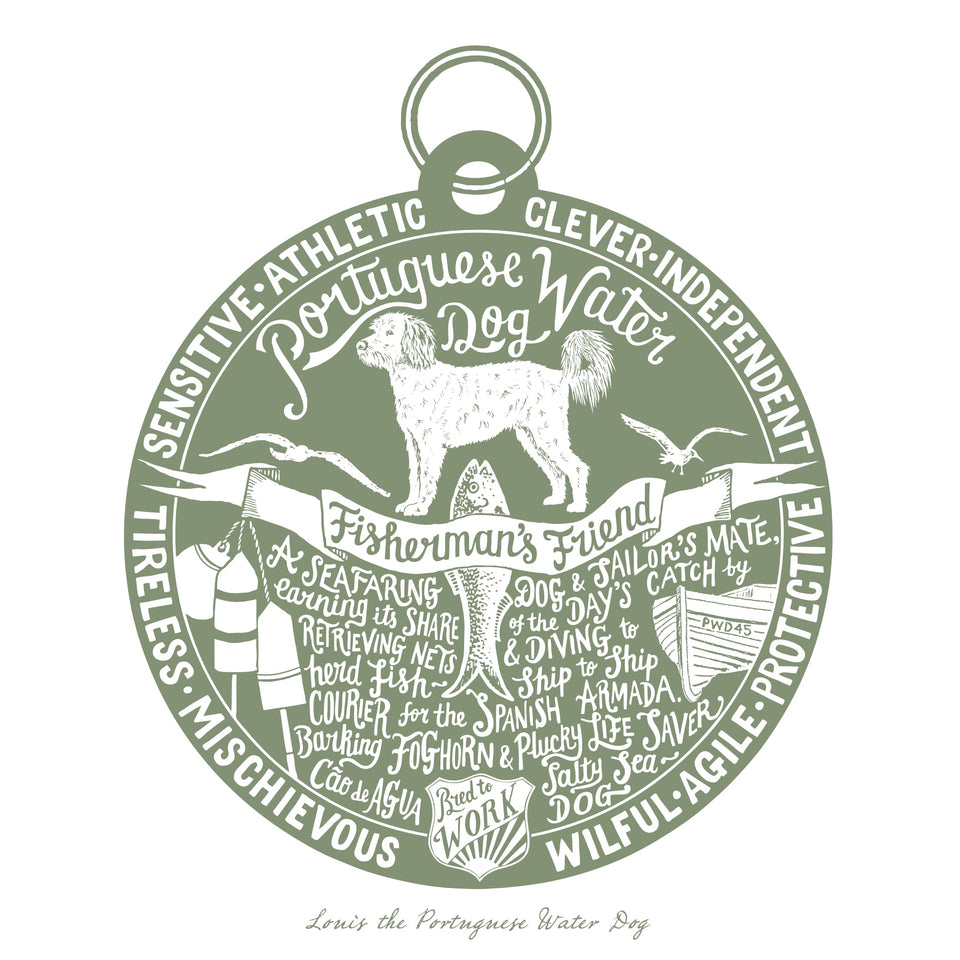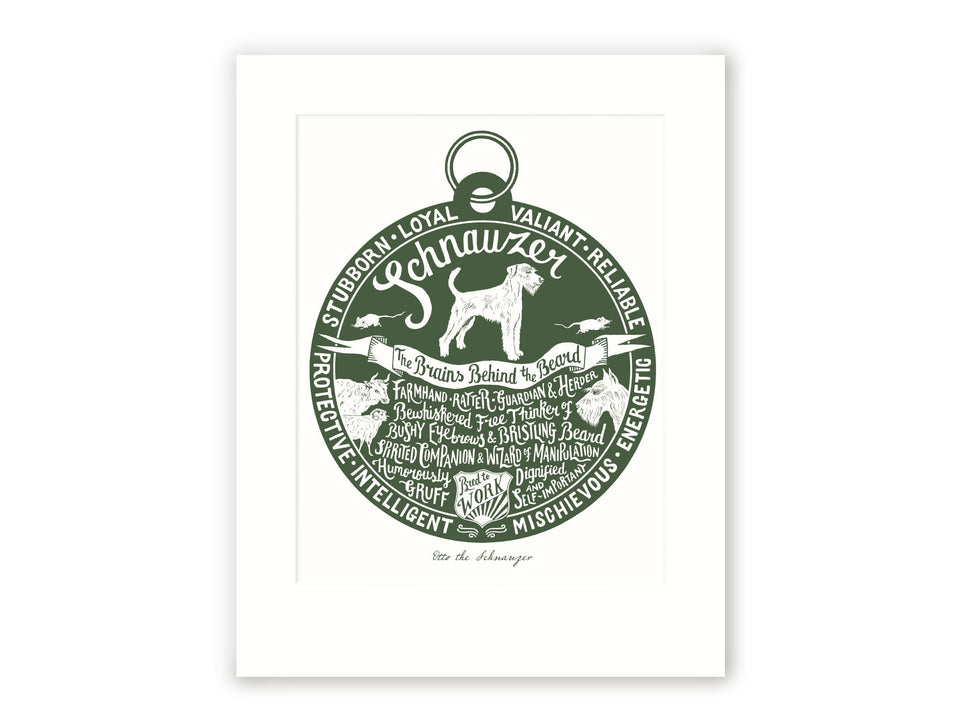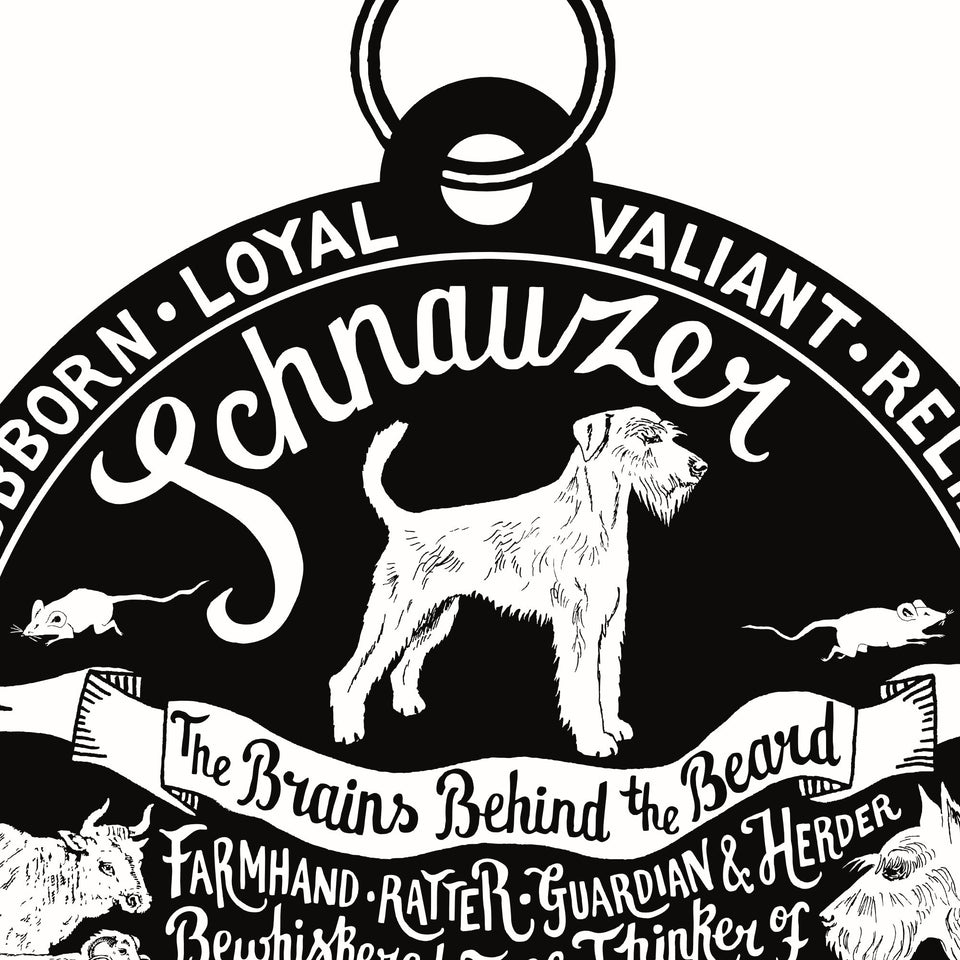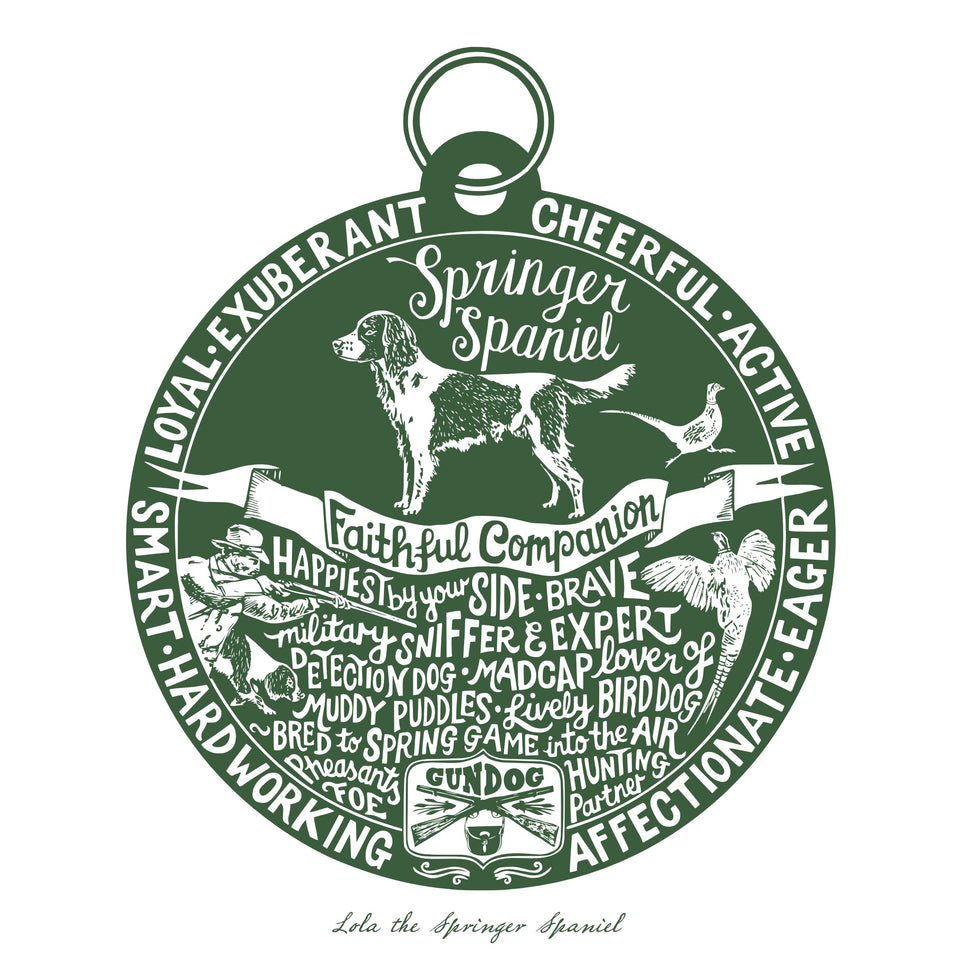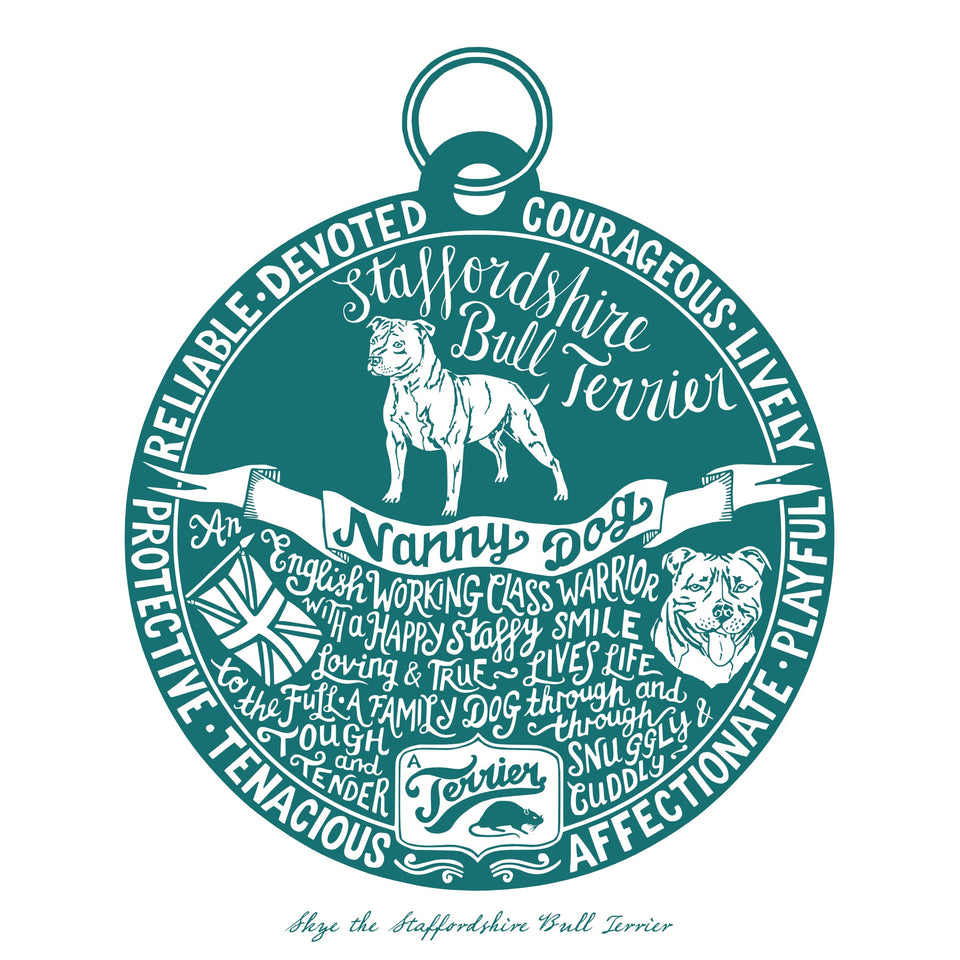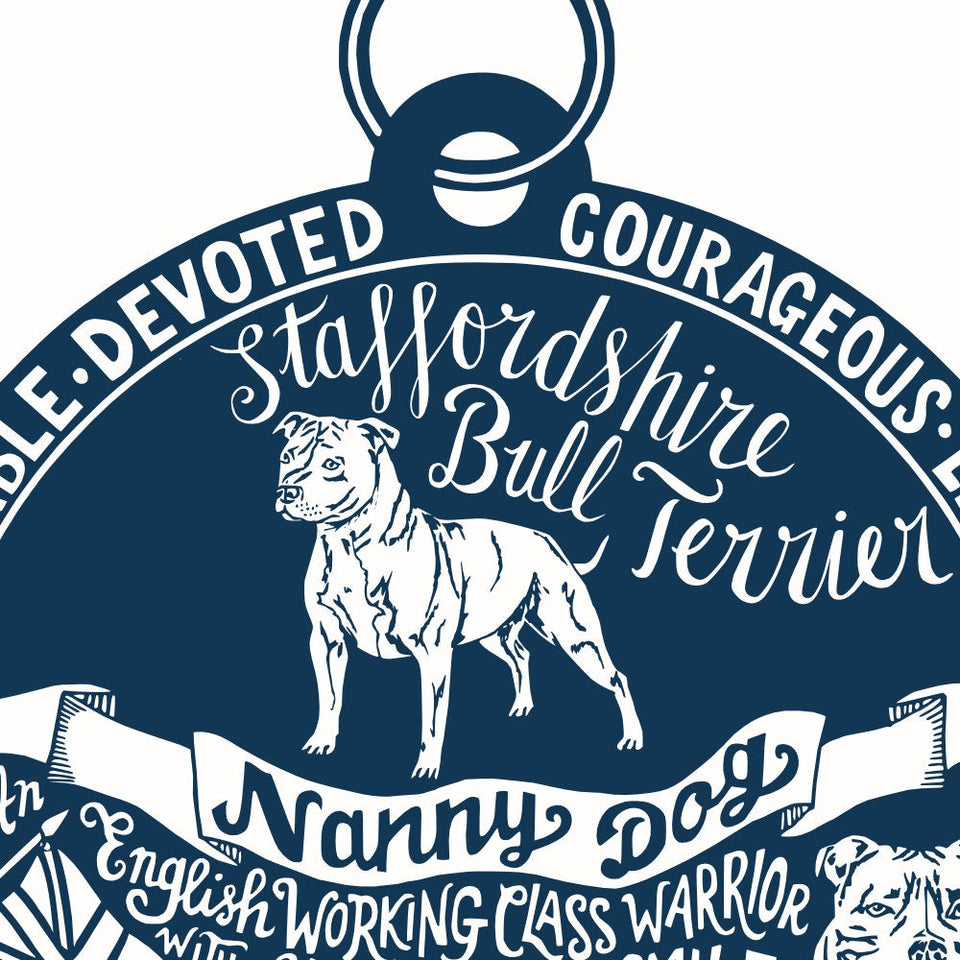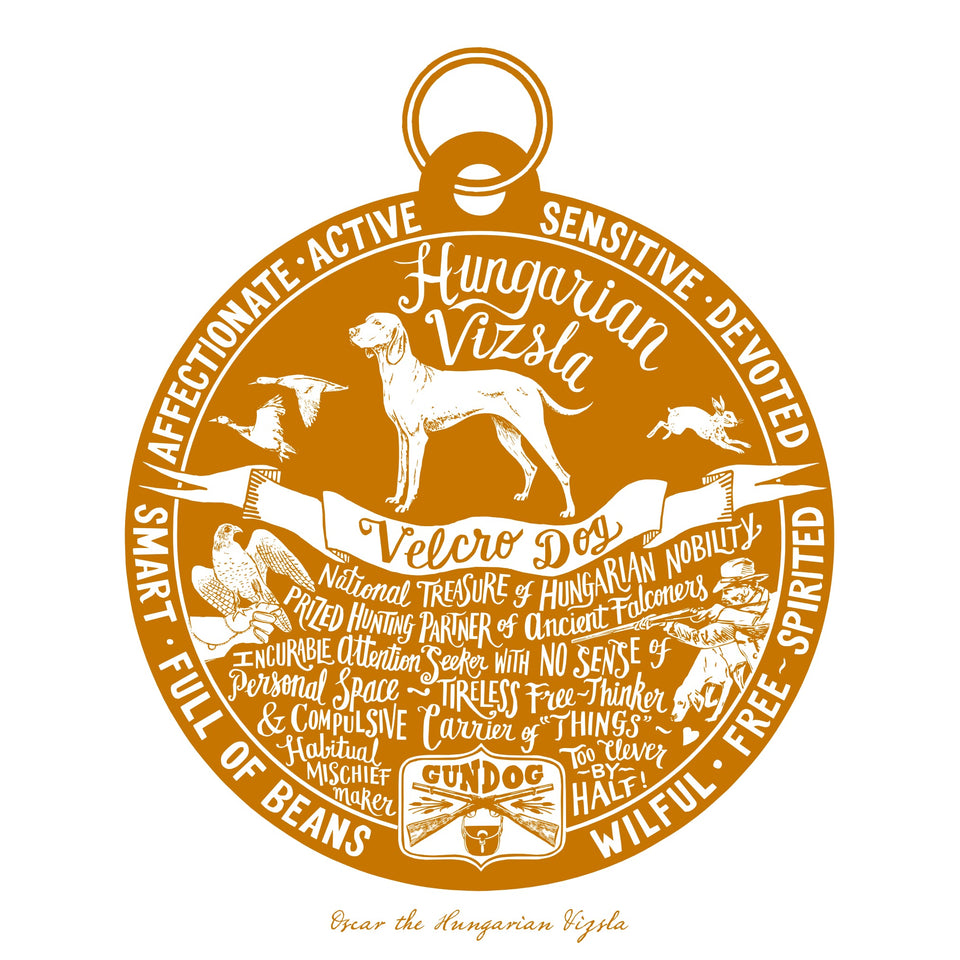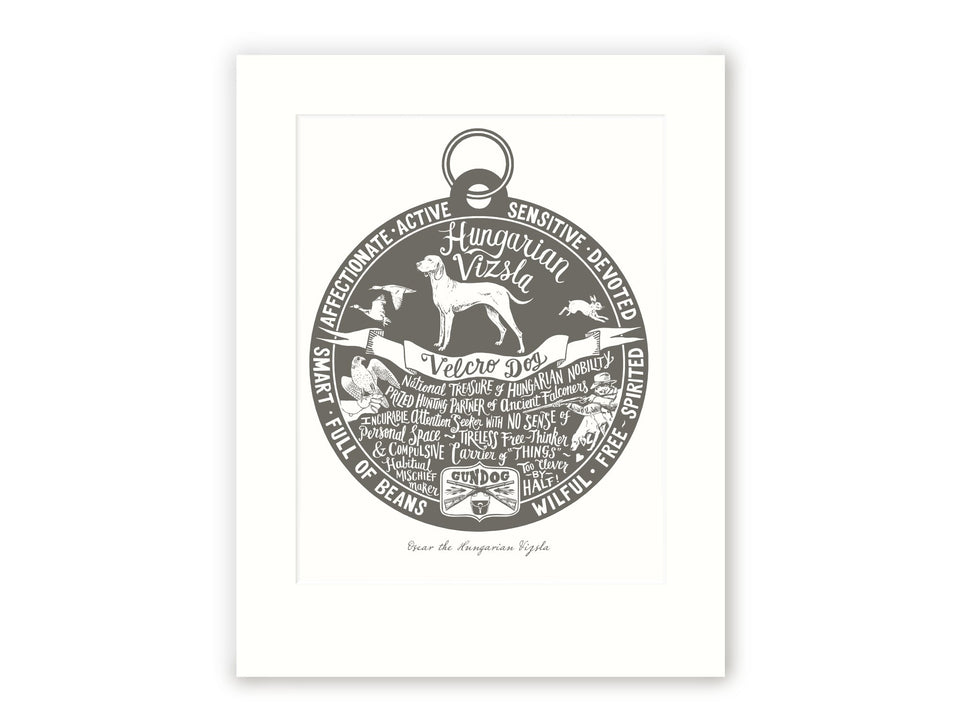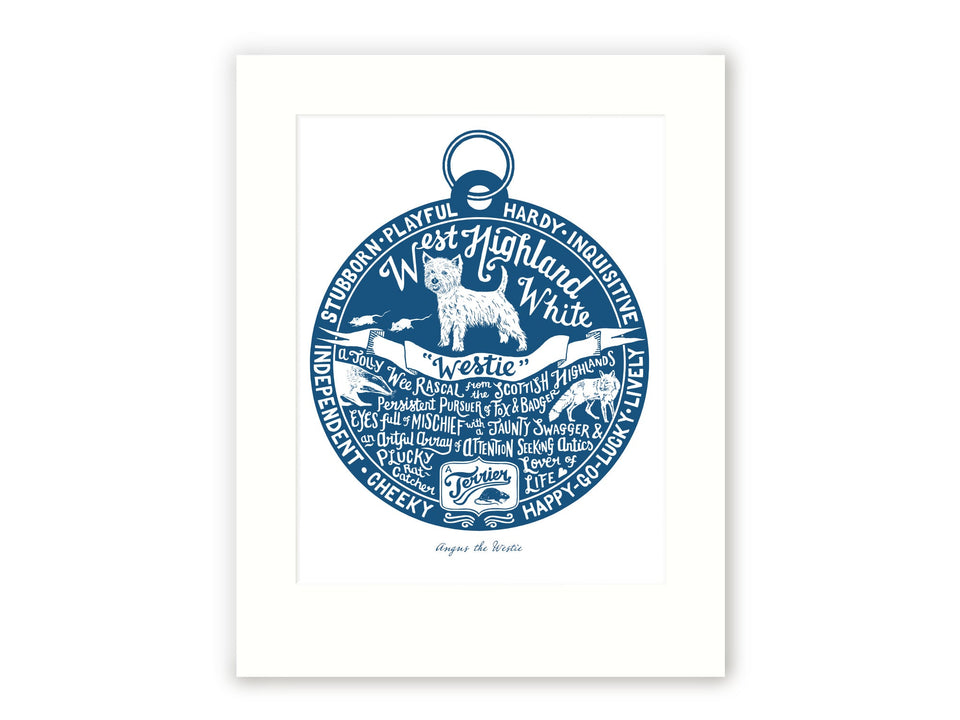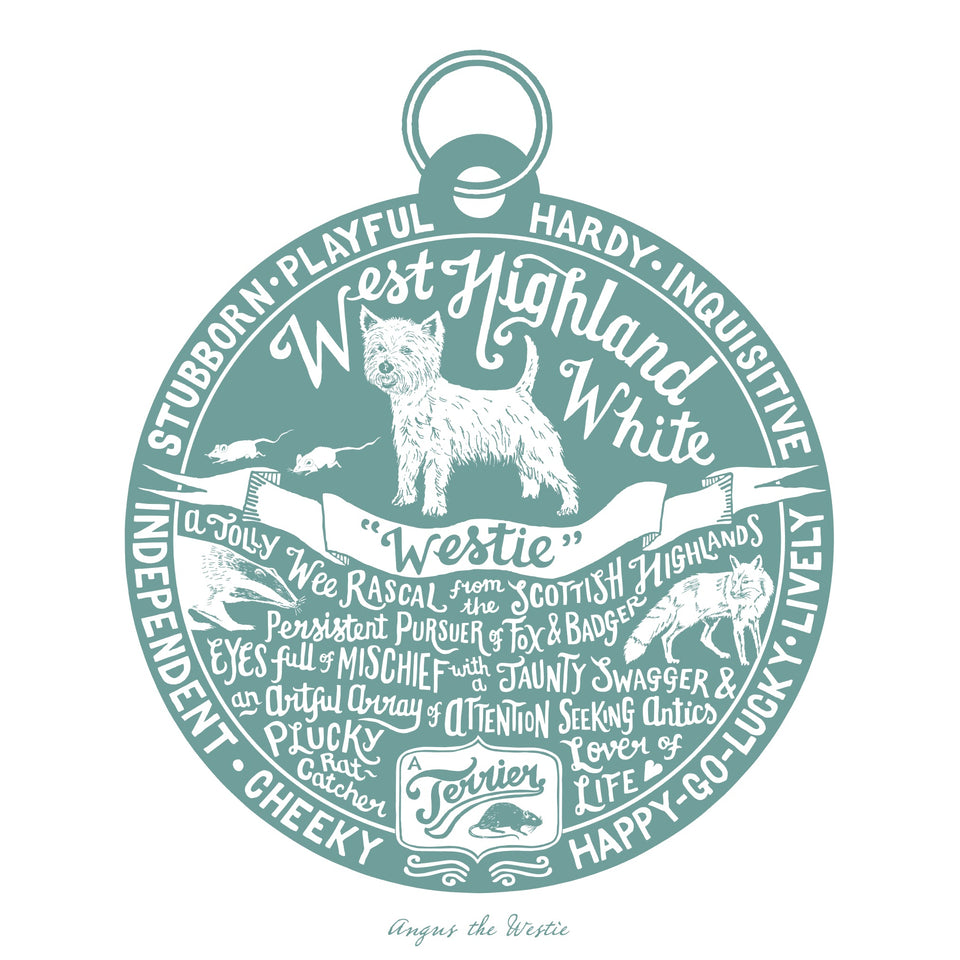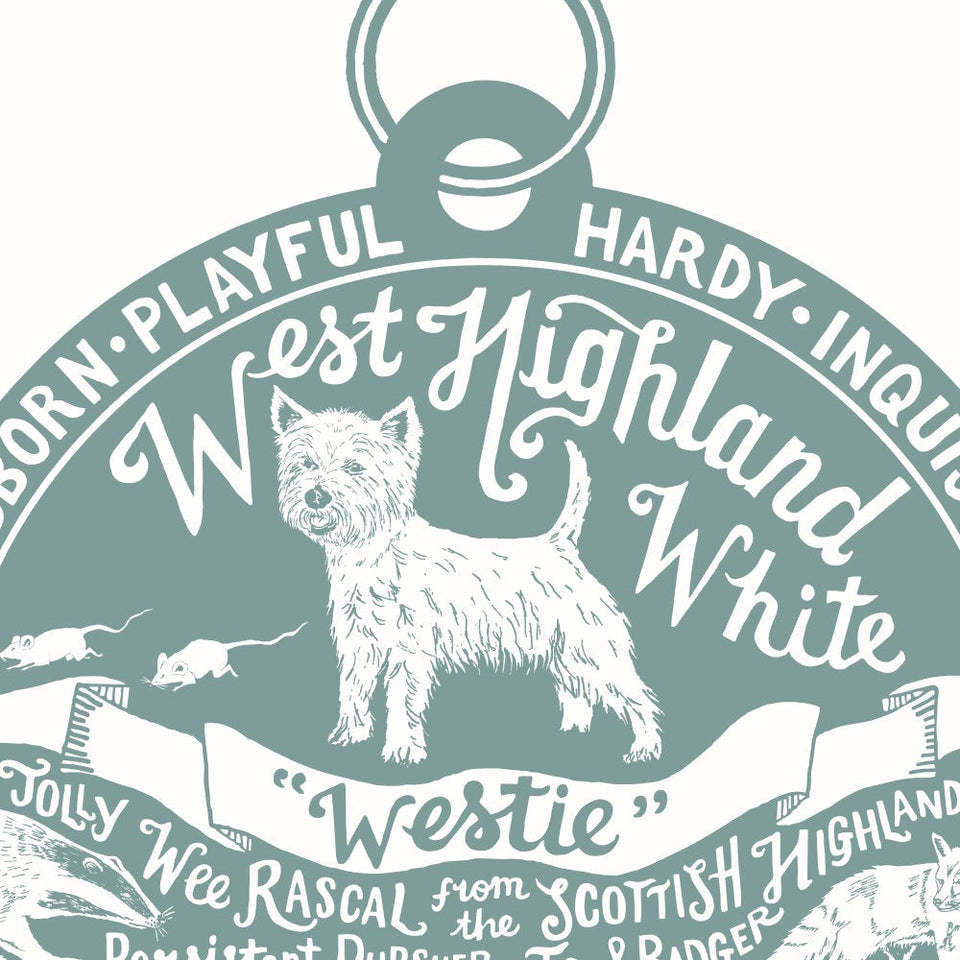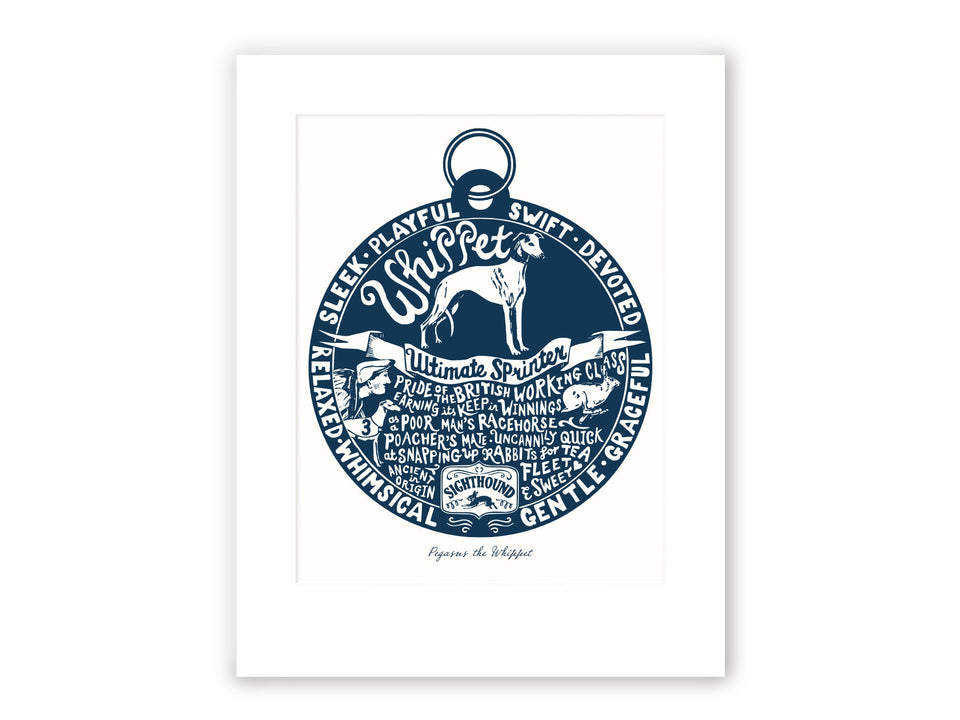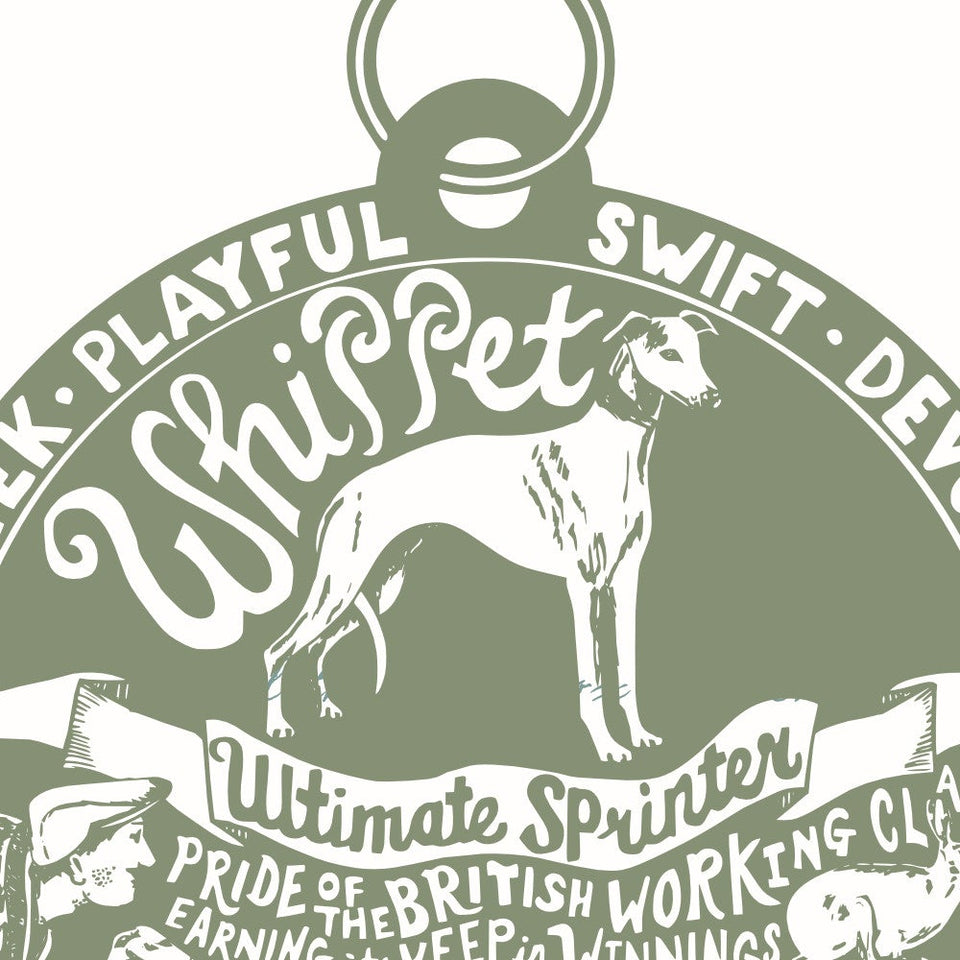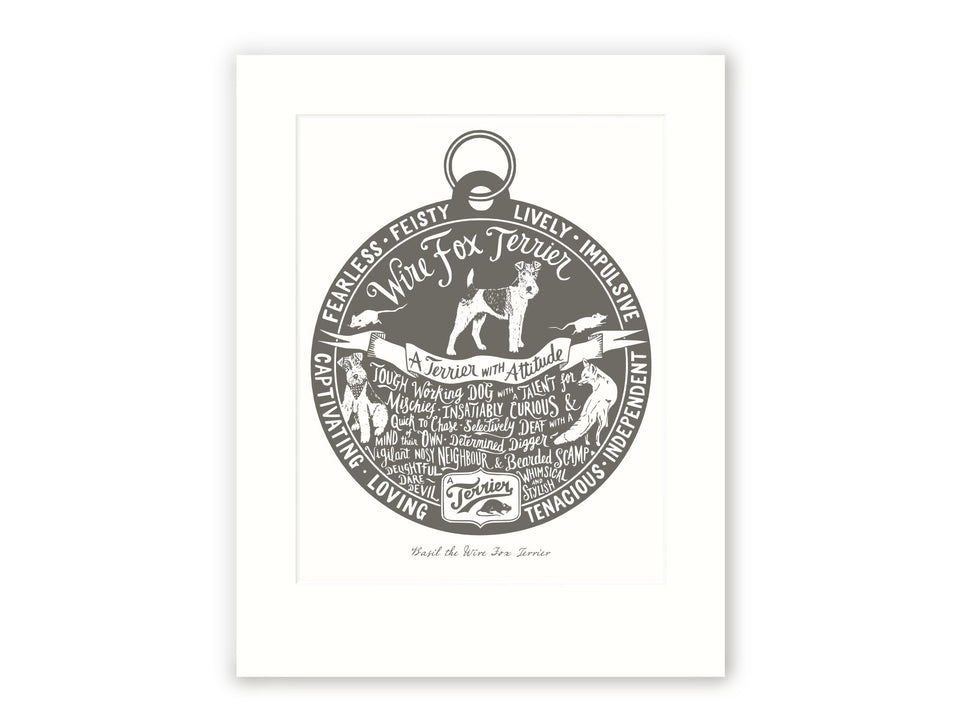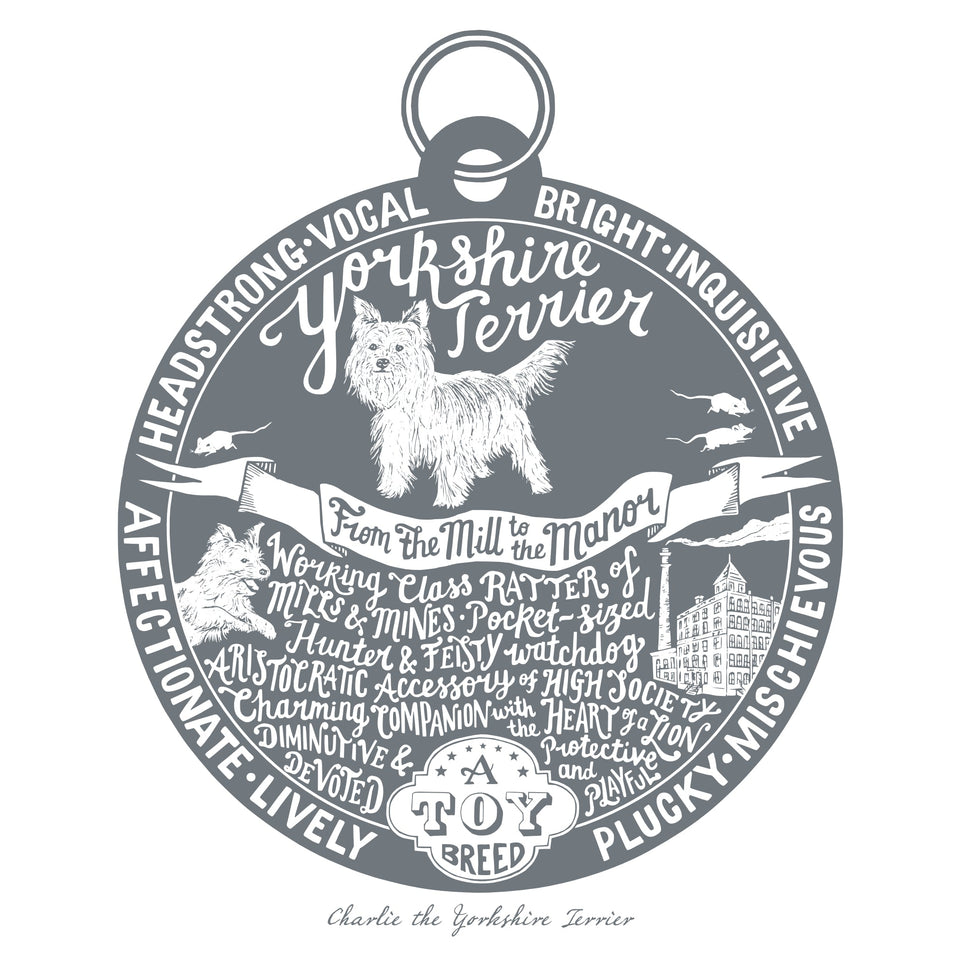Dog Tag prints - 12 Colours, 27 Breeds Available
See the full collection from The Enlightened Hound
£40.00- Choose from 27 popular dog breeds - just choose your dog breed
- Available in 12 standard colours (just choose your colour by adding your chosen colour to 'Additional Comments' box when placing order)
- Blue Grey
- Duck Egg
- Flench Clay
- Warm Grey
- Sea Green
- Woodland
- Storm Grey
- Ochre
- Burnt Orange
- Royal Blue
- Oxford Blue
- Ink Black
- The title of your print can be personalised (add up to 10 words to 'Additional Comments' box when ordering e.g. 'Elvis, the amazing Labradoodle' or state 'No Personalisation'
-
Ships with an acid-free, off-white mount ready to pop into a standard 11 x 14 inch frame of your choice.
-
Archival quality acid-free print on heavy art paper - printed in the UK
-
Please allow up to 3-4 weeks for delivery, often it will be a lot quicker but this is worst case scenario.
About Beagles - These merry little hounds, immortalized by Snoopy, are characterized by an insatiable wanderlust. Always hot on the trail of some olfactory adventure, these greedy gourmands are driven by a single-minded dedication to the pursuit of food. These crafty and ingenious bounty hunters rarely return empty handed!
Originally bred to track small game like rabbit and hare, their extraordinarily sensitive noses and tireless stamina make them expert detection dogs in the battle to prevent smuggling of contraband food, weapons & explosives. Some members of the infamous U.S. Beagle Brigade can detect almost 50 different scents.
About Border Collies - The Border Collie was originally called the Scotch Sheep Dog. “Rough” or “Smooth” coated, they originated in Northumberland along the borders of Scotland and England, and are said to descend from dogs used by the Vikings to herd reindeer and the old British droving breeds, with a bit of spaniel added. A relentless desire to herd (be it sheep, cattle, children or cars) with a crouching pose and mesmerizing stare is characteristic of the Border Collie at work.
Top of the list of neuropsychologist Stanley Coren’s “The Intelligence of Dogs”, the Border Collie is known for its amazing wisdom, understanding and intuition. There are many tales of a Border Collie’s uncanny ability to foresee their owners’ needs and know when something is wrong. An intense desire to work and incredible stamina are the hallmarks of this smart and savvy breed. If they are not given a job to do they will just invent one for themselves (and then get it done - brilliantly)!
About Border Terriers -These rough ‘tweedy’ coated working terriers hail from the area between England and Scotland, historically known as the Scottish Marches, now called the Border Country. It is a dramatic hilly landscape of sweeping valleys, heather moorland and green forests where 18th century farmers and shepherds, in need of some help to control the local fox and vermin population, started breeding Border Terriers.
With its distinctive head shape like a otter and their ‘salt and pepper’ whiskery faces, the Border has won the hearts of many including the pop star Elton John, the tennis player, Andy Murray, the comedian David Walliams and the chairman of the Kennel Club, Professor Dean, who has 12! They have incredible stamina and are game for any challenge.
About Boxers -Bright and bouncy, Boxers are often called “The Peter Pan of Dogs” because they never seem to grow up. Though they look elegant and athletic, Boxers love to play the fool, jumping and romping their way through life in search of fun.
However, underneath all the fun and frolics lies a serious side. Bred to work - a versatile jack of all trades - Boxers have fulfilled a variety of roles with aplomb - from hunting deer and boar to guarding and defending both people and property. They were also used in war time as guards and couriers.
Yet they have an innate desire to help and make wonderful therapy dogs, narcotics detectors and search & rescue dogs. With their charming personalities and unique expressive faces, it’s no wonder that these madcap, mischievous dogs have become such popular companions.
About Bulldogs - Sometimes called the British or English Bulldog, these dogs have a bloody heritage, though today’s Bulldog has come a long way since those early days of bull baiting and its role as a butcher’s companion. Descended from fighting mastiffs with a vice like jaw that clamps shut, Bulldogs were originally used to catch and hold aggressive large prey (like wild boars and unruly bovine) and bring in wild cattle for market. In the early 19th century it was thought that baiting cattle tenderised the meat and made it more nutritious, hence their role as an indispensable butcher’s mate.
Thankfully baiting was outlawed in 1845 and whilst the physical characteristics of the Bulldog still exude strength and power, they are now docile, sweet natured companions. Delightfully ugly and endearingly comical, the Bulldog is the national dog of Great Britain and a British icon that stands for unrelenting bravery and tenacity. No wonder that the Bulldog is the mascot for many a college and sports team.
About Cockapoos - The popular Cockapoo was one of the first deliberate cross breeds with original records dating back to 1960s, or possibly 1950s, in America. The delightful result of this cross between a Cocker Spaniel and Poodle is a happy-go-lucky, smart and totally devoted companion.
About Cocker Spaniels - With their soulful eyes it’s easy to see where the phrase “spaniel eyes” (as in “Don’t look at me with those spaniel eyes!”) came from.
The spaniel is widely assumed to have originated in Spain, with the word “spaniel” thought to be derived from the old French word “Espaignol” meaning “Spanish”. However another theory suggests that the name “spaniel” may come from the French verb “espanir” meaning “to crouch or flatten” (which describes a style of hunting involving crouching and springing).
Cockers and Springers are closely related. Originally these were just different names given to pups of the same litter — the smaller ones called Cockers and the larger ones, Springers. Cocker Spaniels were recognised as a distinct breed by the Kennel Club in 1885.
Immortalised as Lady (in the 1955 film Lady and the Tramp) Cocker Spaniels are no strangers to celebrity status. Famous owners include George Clooney, The Kennedy family, Elton John, Oprah Winfrey, Prince William & Kate Middleton and President Nixon.
About Dachshunds - Despite their cute and comical appearance, Dachshunds are incredibly brave little hunting dogs that were bred to chase and flush out badgers.
Often significantly larger and heavier than a dachshund, badgers are a fierce and formidable opponent, yet the tenacious dachshund with its indomitable spirit is a fearless and efficient hunter. Their long, low body is perfect for getting into the dens of rabbit, fox, wild boar, badgers and other burrow dwelling animals that have gone to ground.
The origin of the dachshund is still debated as there are etchings and statues of similar long, low dogs dating back thousands of years, however 16th century German hunters were responsible for selecting and cross breeding dogs to create the dachshund we are familiar with today. The name Dachshund literally means “Badger Dog” in German.
Not just loved by Germans (they are the national dog of Germany and were the mascot for the 1972 Munich Olympics) dachshunds were popular in the Royal Courts of Europe and have been the dog of choice for many famous owners including Queen Victoria, James Dean, Joan Crawford, Pablo Picasso, David Hockney, John Wayne, Clarke Gable, Madonna and Andy Warhol.
Known affectionately as Sausage Dog, Hot Dog, Doxie, Dashie and Weiner, these adorable and amusing companions are now a favourite the world over.
About French Bulldogs - French bulldogs have a fascinating and colourful history. Thought to be the result of crosses between toy bulldogs and terriers, these roguish little dogs originated in the working mill towns of England.
When the industrial revolution replaced many weavers with machines, Nottinghamshire lace workers went to find work in France, where lace was still being made in the traditional way. They took their beloved dogs with them as they were easy to smuggle on board ship and helped kill rats in the cramped living quarters.
French bulldogs became the favourites of Parisian Belles de Nuit (street walkers) as they made it easy for potential customers to strike up a conversation. Their popularity spread and Frenchies became the fashionable accessory amongst Parisian high society, the artistic in-crowd, shopkeepers and cafe owners.
Famously owned by Toulouse Lautrec, King Edward VII the Russian royal family, Leonardo di Caprio, The Beckhams & Yves Saint Laurent, these sociable, playful dogs love to be the centre of attention.
About German Shepherds - Originally bred in the 1800s by a German cavalry captain, Max von Stephanitz, as a long distance sheepdog herder and guardian of the flock, the German Shepherd is known for its superior intellect, unwavering dedication to work & loyalty to their handler.
It was not long before the GSD was promoted for police & military work and the rest, as they say, is history. An estimated 48,000 dogs were used by the German army in WW1 & WW2 as messengers, rescuers and guardians. Trained for scout duty, they were used to warn soldiers to the presence of enemies or mines and acted as supply carriers through artillery fire.
German Shepherds are pioneers in the use of dogs in community and service work. They are one of the most widely used breeds in scent-work roles (search and rescue, cadaver searching, narcotics, explosives and mine detection) due to their keen sense of smell and their ability to work regardless of distractions.
At one time the German Shepherd was the breed chosen, almost exclusively, to be used as a guide dog for the visually impaired.
They are well known for their work in security and law enforcement and their roles include tracking criminals, detecting controlled substances, patrolling troubled areas and apprehending and holding suspects.
Perhaps the most famous German shepherd is Rin Tin Tin who, as small puppy, was rescued from a bullet and bomb riddled breeding kennel in France during World War I by Corporal Lee Duncan. At the end of the war Duncan brought the puppy back to his hometown of Los Angeles where he trained him, and turned him into one of the most famous dogs in show biz. In Tin Tin appeared in dozens of movies and, at the height of his stardom, got 10,000 fan letters a week.
Famous GSD owners include Franklin Roosevelt, JFK, Herbert Hoover and Picasso.
About Golden Retrievers - The beautiful Golden Retriever was developed by the wonderfully named British aristocrat, Lord Tweedmouth, in the late 1800s, as a handsome and practical gentleman’s hunting companion. Tweedmouth was an avid hunter and well connected gentleman in Victorian society.
In 1865 Lord Tweedmouth bought the only yellow pup from a litter of black wavy coated retrievers and crossed him with the (now extinct) Tweed Water Spaniel, a rugged water dog with excellent retrieving abilities. He wanted to create the perfect sporting dog to retrieve upland game and waterfowl on his Scottish estate, but also an animal that was handsome and of a biddable, sweet disposition — an ideal a family pet. Today’s Golden Retrievers are a testament to those early ideals.
Handsome as a Hollywood movie star, sensitive and intelligent companions, with smiling faces and heart-melting eyes, its hard to resist the allure of a Golden! Their inherent retrieving instinct and strong desire to please their people means that they love to carry things in their mouths - shoes, underwear and soft toys rank high on theirs list of favourite things to collect and present as gifts to their cherished family.
Yet these dogs are so much more than a pretty face. Behind all the glamour lies a versatile and accomplished hunter who loves to be at one with nature. I always smile when I meet a mud-covered Golden out on a walk, fresh from romping through the undergrowth, wallowing in the mud and rolling in all manner of unmentionable substances. They simply love to have a good time with their people. What more could you ask from a dog?
About Greyhounds - “A Greyhound should be headed like a snake and necked like a drake, backed like a beam, sided like a bream, footed like a cat and tailed like a rat.” (Juliana Berners, 1486)
At least 4000 years old, the Greyhound is arguably the oldest purebred canine. Combining speed, grace and exceptional hunting ability with loyal and devoted companionship, the greyhound has been used in the sport of coursing (the pursuit of prey by sight instead of scent) since ancient times. It can reach speeds of between 40 and 45mph.
Pictured on walls of Egyptian Pharaoh’s tombs and owned by King Tutankhamen & Cleopatra 7th, the greyhound has a rich and noble heritage. The greyhound features prominently in Homer’s epic Ancient Greek poem, The Odyssey, about the Greek hero Odysseus and his journey home after the fall of Troy, upon which he is not recognised by anyone but his trusted greyhound, Argus. Having 'Argus eyes' has since become a byword to describe a person with a keen sense of sight.
Frequently a decorative emblem on tombs, the greyhound symbolized noble virtues and the aristocratic way of life. A valued status symbol in Ancient Arabia, the birth of a greyhound was said to be second only to the birth of a son. Their privileged status in society was also evident in the Middle Ages when it was a capital offence to kill a greyhound and only royalty or nobility were allowed to own one (not commoners - who were beheaded if caught with one). This ensured that the elite sport of greyhound racing remained just for gentlemen and nobility.
There is plenty of amusing greyhound behaviour terminology to learn. These big-hearted hunters like to alternate between the “Zoomies” (galloping with abandon on winged feet) and the “Snoozies” (lounging and dozing in comfort and warmth). Many delight in hoarding food and toys in their beds where they may practice “Roaching” (rolling onto their back and spreading their legs at odd angles in all directions, like a dead cockroach) and they may also enjoy a spot of “Roo-ing” (singing or howling).
About Hungarian Vizslas - Vizslas are well known for their insatiable desire to be close to their humans, hence the nickname "Velcro Dog". They are experts at wedging themselves next to their owners, climbing over them and draping themselves around their beloved human companions. They crave attention and are incurable snugglers. An old Hungarian proverb says "If you own a Vizsla, it lives on top of your head"!
Vizslas were prized companions and hunting partners of ancient Magyar warriors who, with the help of their falcons, flushed out prey on the vast plains. They were soon adopted as the dog of choice by Hungarian nobility and Vizslas were sometimes presented to favoured foreign royalty and so came to be known as 'the gift of the kings". Fortunately Vizslas narrowly escaped extinction when the Soviets invaded Hungary towards the end of the second world war.
Vizslas are very clever and are notorious mischief-makers when bored. They frequently out-think their owners and can be especially smart and sneaky when it comes to food - opening cupboards and counter surfing - and nothing is considered out of bounds! Many have a fetish for socks, laundry, tissues, shoes and toilet paper, which they particularly enjoy shredding!
With their trademark sleek, red-gold coat and amber eyes, it's hard to resist their adoring gaze and unending desire just to be loved.
About Jack Russell & Parson Russell Terriers - These popular, feisty little dogs have a long history of assisting people with hunting and vermin control. Their controversial and chequered past makes fascinating reading. The story goes that the breed line was started way back in 1795 by the Reverend John (“Jack”) Russell, a parson with a passion for fox hunting and country pursuits.
The working and sporting owners of Jack Russell terriers of old were vehemently opposed to Kennel Club registration of the breed. They were proud of their hardy little dogs, preferring to call them cross breeds or even mongrels - the words pedigree or pure-bred were anathema to them. Even John Russell, after judging Fox Terriers in the show ring for the Kennel Club, was firmly against any standardisation of the breed, believing that the working spirit of the Jack Russell would be diluted by show breeding, leaving them “constitutionally and generally weaker than their less blue-blooded cousins”
But of course there were those who disagreed and sought to create a breed standard - now known as the Parson Russell Terrier - which is recognised by the Kennel Club. Regardless of Kennel Club recognition, these super little dogs are tough yet affectionate with a larger than life personality. Fearless, agile, quick and energetic, the JRT is a remarkable companion for all walks of life.
About Labradoodles - In the late 1980s The Royal Guide Dog Association of Australia received a request from a blind lady in Hawaii who needed a guide dog that would not aggravate her husband’s allergies. The request was given to a man called Wally Conron who tried in vain to train 33 different poodles as guide dogs but, despite being working dogs, none of them made the grade. In desperation he crossed his best Labrador bitch with a Standard Poodle. Of the three puppies, one of them did not trigger an allergic reaction in the blind lady’s husband and so the Labradoodle was born.
Today Labradoodles are both excellent therapy and assistance dogs and enormously popular family pets. They love to work and are eager to please. They are true companion dogs and thrive best with their people, delighting in being stroked and petted. Many of them are pretty smart and enjoy outwitting their owners - just for fun!
Sensitive noses and tireless stamina make them expert detection dogs in the battle to prevent smuggling of contraband food, weapons & explosives. Some members of the infamous U.S. Beagle Brigade can detect almost 50 different scents.
About Labradors - The Labrador usually tops the most popular breed chart in both the UK and the USA… and now I know why! They really are the most wonderfully versatile dogs and they definitely deserve their status as Top Dog (my Portuguese Water Dog can fortunately never read of my disloyalty!).
Despite often seeing Labs as assistance dogs, it was not until I researched the breed in more detail that I realised just how many different ways Labs have been trained to help humans. These steady, soft-mouthed, warm hearted and waggy-tailed dogs are the perfect companion for so many people.
About Lurchers - A Lurcher is a cross between a Sighthound and a Non-Sighthound (often a herding/pastoral breed, like a collie) to produce an athletic hunting dog.
In England, in the Middle Ages, only the nobility could own pure bred dogs. After the conquest in 1066, the Normans passed laws preventing commoners from owning purebred greyhounds and Forest Law protected huge swathes of forest for Royalty and the King to hunt. By the late 12th century almost one third of southern England was Royal Forest.
Accidental crossbreeds of these nobility owned sighthounds were snapped up by the commoners (peasants and gypsies) as stealth poaching dogs, who hunted by scent and sight to put meat for the cooking pot on the table. Rabbit and hares were the usual quarry and hunting usually took place at night.
These dogs were the perfect combination of intelligence, speed, agility, hardiness, temperament & trainability. It was essential that the purebred Greyhound hunting instinct was tempered so that the dogs could be stopped from chasing prey if someone was watching. The penalty for detection was death, so dogs had to be loyal, trainable and live out of sight in the family dwelling
The name Lurcher is thought to come from the ancient Romany word "lur" which means thief and "cur" meaning a mixed breed dog. Over the centuries it became one word - Lurcher.
About Poodles - The poodle is an ancient breed, said to have originated in Germany and standardized in France, where it is the national breed. In France, poodles are called “caniche” a name derived from chien canard, meaning duck dog. The French have and old expression "fidele comme une caniche" (faithful as a Poodle).
Many overlook the smart, funny Poodle, thinking him frou frou and put off by all the hair-dos and eccentric things people do with their coats, yet this wiry, waterproof coat was essential for its original job as a water retriever, bred to work and retrieve waterfowl for hunters from swamp, marsh & river. The name poodle comes from the German word pudel, or pudelin, which means to splash in the water.
Smart as a whip with a dignified attitude, the poodle has a goofy streak and loves to play. Its trainability, agility and clownish personality make the poodle a natural-born performer & entertainer - the perfect circus dog. It is thought that circus gypsies first cut the poodles coat into fanciful shapes, a trend that quickly caught on amongst upper class french ladies whose toy poodles were the ultimate fashion accessory and lap dog.
Famous poodle owners include Joan Crawford, Duke Ellington, Barbara Streisand, Jack Lemon, Winston Churchill, Queen Elizabeth, John Steinbeck, Richard Nixon, Priscilla Presley, Kirk Douglas, Joan Crawford, Grace Kelly, Marylyn Monroe, Judy Garland, George Washington, Geroge V, Elizabeth Taylor, Ivana Trump, Walt Disney and Mariah Carey.
About Portuguese Water Dogs - Debbie of The Enlightened Hound has a Portuguese Water Dog, these fantastic dogs are very close to her heart!
They are intelligent, strong, energetic, sensitive and affectionate. Historically a seafaring dog, the “Portie” worked alongside Portuguese sailors for centuries, earning his share of each day's catch of saltwater codfish.
Porties worked tirelessly, swimming to retrieve broken nets, diving to herd schools of fish, and acting as a barking foghorn. They also carried messages between boats, and to shore and acted as guard dogs, protecting the sailors' fishing trawlers and their homes.
One important job was to prevent gulls from landing on the boat and stealing the catch. My Portuguese Water Dog (Figo) does his best to prevent birds landing in our garden - I wonder if he thinks he is protecting our ‘catch’?
About Pugs - The pug is often characterised by the Latin phrase “multum in parvo” which means “much in little”. This refers to the fact that these little dogs have such huge personalities!
Pugs have a fascinating history dating back to ancient China. Also known as Foo Dogs in the West, they were bred by the Chinese Imperial Family of ancient dynasties to resemble the sacred Chinese Guardian Lion. Historical documentation indicates that pugs could only be owned and bred by emperors and breaking this law was punishable by death. A very desirable feature was the "W" shape in the forehead folds, which in Chinese letters meant prince.
Pugs were treasured companions who were held in the highest esteem. They lived in the lap of luxury, eating only the best food, with their own devoted attendants to look after them and special carriages to ride in (not that different from today then!)
Pugs have long been associated with royalty, favoured as companions by several European royal households. From a Russian princess to the Dutch king, William I, French ruler Louis XIV, and British monarchs, King William III, Mary II, Queen Victoria and Edward VII and more recently The Duke & Duchess of Windsor. A more royal pedigree could not be found!
Fame and fortune go hand in hand with these great little dogs. Other celebrity owners include Josephine Bonaparte, Winston Churchill, Andy Warhol, George Clooney and Grace Kelly. Pugs have also been immortalised in many movies and books, perhaps the most famous of which is Frank the Pug in Men in Black - an extra-terrestrial living on Earth in the disguise of a pug!
About Schnauzers - Originating in Germany as farmhands, these versatile working dogs have been put to many uses, both on the farm (herding livestock, rat catching, guarding, retrieving) and in the wider community (military messenger, dispatch carrier, security & police dog). Frequently called the ‘thinking dog’ or the ‘dog with a human brain’, the schnauzer brings to mind a sage wizard, with its profuse whiskers and a gleam of intelligence in its eyes. A schnauzer was the first dog trained to detect cancer cells.
Now in 3 sizes (miniature, standard and giant) these lively, independent thinkers may look like dignified professors but they also like to let their hair down!
About Springer Spaniels -When you talk to Springer Spaniel owners about their dogs, the most frequent word that they use to describe them is ‘mad’! The next thing they talk about is how they just love to be with you, whatever you are doing and wherever you are going. The phrase ‘Velcro Dog’ (as in ‘sticks to you like Velcro’) also cropped up quite frequently.
Completely devoted to their owners, it isn’t hard to imagine how the phrase to “follow one around like a spaniel” came into being.
Like the Cockers favoured by the Kennedys and Nixon, Springers are also the choice of American Presidents - this time the Bush family.
The spaniel is widely assumed to have originated in Spain, with the word “spaniel” thought to be derived from the old French word “Espaignol” meaning “Spanish”. It may have been the Romans who were responsible for bringing these ‘Dogs of Spain’ to other parts of Europe.
However another theory suggests that the name “spaniel” may come from the French verb “espanir” meaning “to crouch or flatten” (which describes a style of hunting involving crouching and springing).
They are extraordinary sniffer dogs and have been credited with saving countless lives in service due to their ability to detect bombs, explosives and weapons. They can also sniff out drugs, contraband mobile phones in prisons, bumble bee nests or illegal immigrants!
Staffordshire Bull Terrier - The popular Staffie is much misunderstood and often unfairly maligned by the media. They are (according to Kennel Club statistics at the time of writing) Britain’s 5th most popular dog, yet they also top the list of breeds in rescue centres and shelters in the UK. The truth is that while the Staffie might look like a tough dog, they are actually big softies - a loving, reliable and affectionate family dog, devoted to their human companions.
The Kennel Club recommends the Staffordshire Bull Terrier as being particularly suitable for families with children - one of only 2 breeds to deserve such a high accolade - and they describe the Staffy as “extremely reliable, highly intelligent and affectionate, especially with children."
Created in England in the late 18th and early 19th century, Staffies were a cross between Bulldogs and Terriers, bred for the ‘sport’ of dogfighting by working class men. Staffies were expected to live harmoniously with their families, often in small spaces with lots of children. No aggression towards humans was tolerated and it is said that any dogs showing even the slightest signs of ill will towards their family members were ruthlessly weeded out.
Their reliable, loving nature and affinity for children is the reason that Staffords have earned the nickname “The Children’s Nursemaid” or “Nanny Dog”
About West Highland White Terriers - There’s rarely a dull moment with a Westie around. Full of self importance, these cheeky, happy little dogs greet life’s adventures with a twinkle in their eye and a jolly disposition.
They hate to be ignored and their repertoire of shameless tactics for getting attention include the “poor me” stare, the woeful sigh and the pitiful whine. If that fails, they can always fall back on some good old mischief making!
They are a working terrier, at home amongst scree, rocks and cairns. Tireless and brave, the story goes that, in the late 1800s, Donald Malcolm (16th Laird of Poltalloch) owned a reddish brown terrier, that was accidentally mistaken for a fox while hunting game, and shot. As a result, Malcolm decided to develop a white terrier breed, which became known as the "Poltalloch Terrier”, the pre-cursor of the West Highland White.
About Whippets - Whippets have a wonderful history that is thought to date from ancient civilisations, who depicted whippet like dogs in their art on temple walls and pottery. The name Whippet is thought to derive from the old English terms ‘whippen’ meaning ’to whip’ which can also mean ’to move smartly or quickly’.
They, of course, are renowned for their speed which led to their popularity amongst the British working class as racing dogs. Races took place in fields or on town roads and were a great day out for the whole family. Whippet racing was taken very seriously as a good dog could add a significant amount in winnings to a weekly wage. A good racing whippet was a cherished addition to the family and were fed with the choicest available meat, even if the family had to ‘go without’.
Whippets were the perfect poacher’s companion due to their skill at catching rabbits, yet being small enough to hide under a coat.
About Wire Fox Terriers - Immortalised in 1929 as Snowy, Tintin's lovable companion, Wire Fox Terriers have a special place in the hearts of dog lovers around the world. Originally bred as tough working dogs with a strong prey instinct, the fearless Wire Fox Terrier would pursue its quarry, usually foxes and vermin, with a relentless determination. Predictably quick to chase anything that moves, the Wire Fox Terrier is prone to selective hearing when it's nose is to the ground in hot pursuit.
They take their neighbourhood watch duties very seriously, diligently alerting their humans to both innocent passers-by and perceived intruders with plenty of vocal warnings! These strong-hearted risk takers like to think they have the upper paw - stubborn, impulsive and insatiably curious, they always live life to the full. They love to dig and are often found landscaping the garden or digging their way to freedom.
These little fire crackers are a bundle of energy and intelligence with bags of personality to boot. Their dark, round eyes, trademark beard and wiry coat give them an air of mischief and style that is hard to beat.
About Yorkshire Terriers - Yorkshire Terriers were originally bred in England by ordinary working men to catch rats in factories, mines and mills. They were also handy hunting partners for ferreting out badgers and foxes from their dens and burrows, as the Yorkie could be carried in the hunter’s pocket until needed.
Prior to 1874, they were known as Broken-Haired Scotch or Toy Terriers until a reporter commented at a show that they had much improved since coming to Yorkshire!
As more breeders and fanciers promoted the breed in the Victorian era, it became the most desirable companion for ladies. Pretty, playful, personable, portable - many a be-ribboned Yorkie sat in a fancy carriage on satin pillow alongside its owner, thus making a smooth transition from its working class roots to high society.
Today, Yorkies come in many guises. Whether a silky smooth, long haired show dog, with a bow in their hair and a jewelled collar or an adorably scruffy little urchin with a thirst for adventure, these tiny & terrific dogs will always be a terrier at heart.
Thanks for continuing to buy British handmade ethical gifts & unique art from Cherrydidi. Finding that perfect gift for a Mum, Dad, brother, sister, your kids, girlfriend, boyfriend, special woman or man in your life, a special friend or even the home, can be a real challenge so we’re glad to have helped. We are a little like Not on the High Street and Etsy but the main difference is we have a real shop you can walk into as well as finding beautiful things online too!
Whether you visited our shop/gallery in Keswick, The Lake District (and met the famous Zak the Collie Dog) or have found us online, buying a gift or piece of art from us will in turn support these talented independent artists and creative businesses - we couldn't do it without you, so thank you for supporting us!

Shipping and returns
Delivery charge depends on the delivery postcode and the contents of your order. You will only pay one delivery charge per address - please read options below.
If you have purchased various items please be mindful they will arrive separately as you have supported different artists.
Thank you for continuing to support the 'Cherrydidi Online Shop' and our artists.
All options are available at check-out:
Standard Delivery - £3.60 (up to 2kg in weight) - Receive in 7 working days. This method covers up to £20 compensation for loss or damage.
Special Delivery - £11 - Receive in 7 working days. This method covers up to £500 compensation for loss or damage. We strongly recommend selecting Special Delivery for orders over £50.
International Tracked & Signed Delivery: Europe - £14.90 (up to agreed dimensions/weight) - This method covers up to £250 compensation.
International Tracked & Signed Delivery: Worldwide - £24.70 (up to agreed dimensions/weight) - This method covers up to £250 compensation.
International orders will normally be received within 7-14 working days, depending on the destination.
Help
Thanks for continuing to buy British handmade ethical gifts & unique art from Cherrydidi. Finding that perfect gift for a Mum, Dad, brother, sister, your kids, girlfriend, boyfriend, special woman or man in your life, a special friend or even the home, can be a real challenge so we’re glad to have helped. We are a little like Not on the High Street and Etsy but the main difference is we have a real shop you can walk into as well as finding beautiful things online too!
Buying a gift or piece of art from us will in turn support these talented independent artists and creative businesses - we couldn't do it without you, so thank you for supporting us.
